Monsters & Marvels









January 2023
Monsters and Marvels are certainly as old as our planet earth. This fascination comes from a need to express human fears but is also a way to depict men’s vices. Our understandings of humanity, power, community, the divine and even death and the afterlife have been shaped since antiquity by myth, literature, performance and art. The monsters and marvels offered artists the opportunity to let their imagination run wild.
This catalogue is dedicated to the representation of the monstrous and the marvelous from multiple cultural perspectives.
The objects are presented with a full description and corresponding dealer’s contact information. Unlike auction sites or other platforms, we empower collectors to interact directly with the member dealers for enquiries and purchases by clicking on the e-mail adress.
In order to guarantee the quality of pieces available in the catalogues, objects are systematically validated by all our select members, who are the in-house experts. Collectors are therefore encouraged to decide and buy with complete confidence. In addition to this, we propose a seven-day full money back return policy should the buyer not feel totally satisfied with a purchase.
Feel free to ask the price if the artwork is listed with a price on request.
« Beware; for I am fearless, and therefore powerful. I will watch with the wiliness of a snake, that I may sting with its venom. Man, you shall repent of the injuries you inflict. »
Mary Shelley. Frankenstein
Sculpture
Fon Benin
First half of 20th century
Wood, wax, cotton fabric, metal, glass
beads, and ritual matters

height: 81 cm
Provenance:
Private Collection, France
Olivier larroque, nîmes
Price: 9.500 euros
T.: +34 (0) 667525597
E.: galeria@davidserra.es
W. : www.davidserra.es
v ETTE d




Sculpture
Burma
Sacrificial material
height: 17 cm
Price: 2.500 euros
O BJECT Pr ESE n TE d By:
Joaquin Pecci
T.: + 32 477 43 94 12
E.: joaquin.pecci@skynet.be
W. : www.joaquinpecci.net
v ETTE d By:



rare, large Shintō or yamabushi hanging Mask of the Beshimi Type
Japan
Edo period
18th - 19th century
Cedar wood, crystal or glass, paper, ink, metal nails
h 40,8 x W 26 x d 16 cm
Inv. nr. 19.003
Price on request
O BJECT Pr ESE n TE d By:
Galerie kommoss
M.: +49 177 6033 201
E.: info@galeriekommoss.com
W.: www.galeriekommoss.com
a large ceremonial pilgrim hanging mask of the beshimi type. a beshimi is some sort of Tengu who protects others from evil spirits and demons. his name refers to his firmly shut mouth, that can be read as a sign of his inner determination. The mask is finely carved with a fearsome facial expression. Over his chunky nose, piercing eyes are testing his observer and his intentions. They are inlayed in the unique Japanese manner called gyokugan (lit. “crystal eyes”). These are eyes made of rock crystal with layers of painted paper for the pupils, which were inserted from the back into the head of the mask to produce a fantastic, realistic appearance.
Clues about the function of this mask gives us a woodblock print by Utagawa hiroshige from his series The Fifty-three Stations of the Tōkaidō from 1832/1833. In the 12th sheet of his series, hiroshige is depicting travelers who are approaching the town of numazu near Mt. Fuji, just as the full moon arises at the horizon. One of the travelers, however, is a pilgrim who is journeying to kompira Shrine on Shikoku Island. The pilgrim is dressed in white and carrying a portable shrine on his back that has been adorned with a large Tengu mask, believed to offer talismanic protection. The kompira shrine is dedicated to the deity Omono-nushi-no-Mikoto, a patron saint of seafarers, and located high atop Mt. kotohira. hence it was also a popular destination of the so called yamabushi, wandering priests who venerate mountains and their spirits and undertake severe ascetic practices to become Buddha in this very life. Carrying large masks of Tengus, the yamabushi themself became associated with these mythical birdlike creatures that live deep in mountain forests.
v ETTE d By:
This mask too may have once undergone its pilgrimage with a yamabushi to kompira or another shrine, being charged with magical

blessings and was then hung in a shrine or Buddhist temple for protection. Compared to another extant large beshimi hanging or offering masks from the national Museum of asian art (F2003.5.13), this one is an extraordinarily fine example with unusual crystal eyes and fearsome expression. Since Shintō items are usually burned within the ritual context of offerings, masks of these type are extremely rare.

Monpa or Sherdukpen, arunachal Pradesh or Bhutan
19th - very early 20th century
Wood, pigment height: 23 cm
Provenance:
Ex roger hollander collection
Price:
This striking mask is extremely well carved and displays significant age. The image seems to convey the impression of a bat/vampire type creature of the night. This is a fine example of the type of mask found in what was formerly known as the nE Indian Frontier where the borders of Bhutan and arunachal Pradesh meet.
O BJECT Pr ESE n TE d By: Thomas Murray
M.: + 1 415.378.0716
E.: thomas@tmurrayarts.com
W. : www.tmurrayarts.com
v ETTE d By:




Mask Ibibio nigeria
Wood height: 23 cm
Provenance:
Old English collection
Galerie renaud vanuxem, Paris
Max Itzikovitz, Paris
Private collection, Paris
Price on request
O BJECT Pr ESE n TE d By:
Pablo Touchaleaume
M.:+33 (0)6 89 90 75 70
E.: pablo.touchaleaume@hotmail.fr
W.: www.pablotouchaleaume.com
v ETTE d By:


Mask Bwa
Burkina Faso height: 32 cm
Provenance: Old american collection Price on request
O BJECT Pr ESE n TE d By:
Olivier Castellano
M.: +33 6 11 21 25 22
E.: info@oliviercastellano.com
W.: www.oliviercastellano.com
v ETTE d By:

Mask of General liu Bei, deified as Guangong, the God of War nuo theater tradition, Sichuan Province, Southwest China
19th century
Wood with polychrome pigments
5 1/2" (w) x 10 3/4" x 3" (d)
Price: 3.800 USd
nuo theater masks were worn by traveling actors/ dancers who would wear the masks to perform at ritual ceremonies to exorcise a village of evil spirits and ghosts. This is a highly unusual example of a nuo mask as it has two faces: General liu Bei is depicted on the outside, but beneath him is the face of Guangong, the God of War.
O BJECT Pr ESE n TE d By:
Joe loux
T.: +1 505 695 6626
E.: joe@joeloux.com
W. : www.joeloux.com
v ETTE d By:




Mask
East of k asai river on Frontier between d. r. of Congo and angola height: 10,2 cm
Provenance:
Thomas alexander III, Saint louis
Publication:
Intimate Conversations, african Miniatures. Preface heinrich Schweizer
Milan, Five Continents. 2017 #143
Price on request
This is one of the finest small Salampasu masks in the world. living east of the k asai river in democratic republic of Congo (formerly Zaire), the Salampasu are a warrior people with no centralized form of government. Their masks and figure sculptures are made for use in initiation rites and ceremonies. The costume of the mask, comprised of animal skins, fiber and feathers, is sacralized, that is, the spirit is in the costume as well as the face covering. The entity of mask/costume is called akish; when it is worn – that is, possessed by the spirit, it is called mukish. This mask may have been used by an individual as a fetish protecting a box.
O BJECT Pr ESE n TE d By: James Stephenson
M.: +1 646.644.7156
E: info@stephensonafricanart.com
W. : www.stephensonafricanart.com
v ETTE d By:


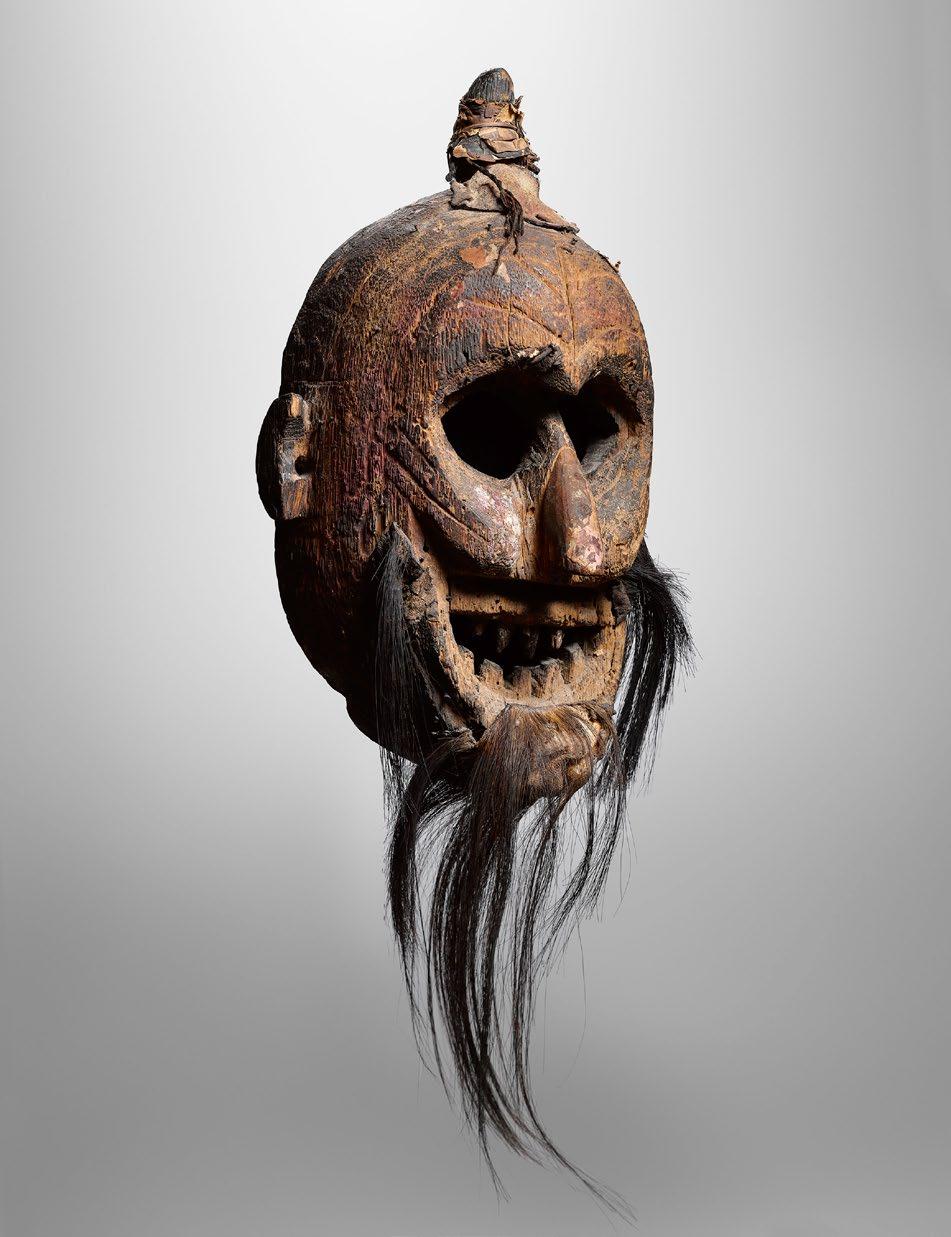
Mask laos / China
End of the 19th century Wood, leather, metal height: 34 cm (without the beard)
Provenance: Private collection, Paris Special price: 3.800 euros
Worn exclusively by the shaman, this formidable mask is intended to scare away evil spirits, especially before a hunting expedition or in the event of an epidemic.
O BJECT Pr ESE n TE d By: Olivier larroque
T.: +33 (0)6 80 08 00 93
E.: o.larroque1@gmail.com
W.: www.olivierlarroque.com
v ETTE d By:
“It does play into my personal egomania because artists spend a long time trying to create a powerful symbol but when you do what I’ve done you become a powerful symbol. I am essentially a mythological creature that exists in cultures around the world: I am a reptilian humanoid.”
Erik Sprague aka The Lizardman
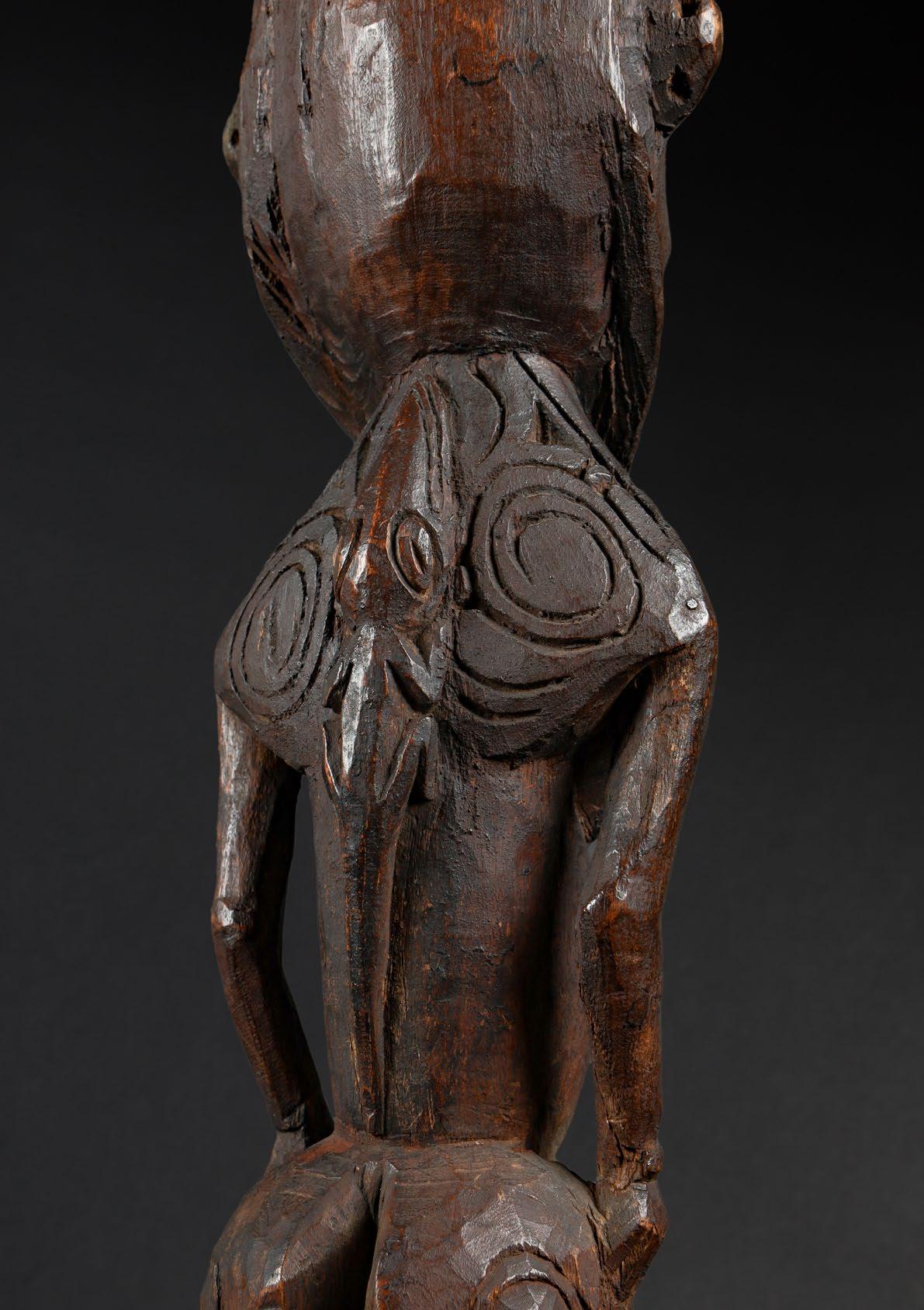
Important k andimbong ancestor figure
Sepik river delta, probably kopar or Singarin, lower Sepik, Papua new Guinea
late 19th century
Carved wood and pigments
height: 59 cm
Provenance:
Field-collected in 1913-1914 by Earl Birger Mörner (1867-1930)
Birger Mörner collection, Stockholm, inv. 1213
Jan lundberg collection, Sweden
Price on request
O BJECT Pr ESE n TE d By:
Julien Flak
M.: +33 6 84 52 81 36
E.: contact@galerieflak.com
W. : www.galerieflak.com
The impressive ancestor figure presented here is emblematic of the cultures of the lower Sepik in Papua new Guinea.
k adibon (or kandimbong) figures from the Sepik river delta region may vary in sizes. The smallest of them were worn as amulets. The larger ones, as our example here, are much rarer. Our figure represents an important clan ancestor, as indicated by the lizard totemic figure carved on his back.
It features deep curvilinear carved motifs on the chest and shoulder blades. The depiction of a lizard in high relief is exceedingly rare and noteworthy.
The provenance and collection date prior to World War I are also historically important.
This incarnation of a powerful clan ancestor played a prominent role in the initiations of young men. It also served during events marking different stages in their lives (war, rituals or social events).
Guardians of the clan’s well-being, these figures were kept in the Men’s house. a place for sharing and discussion, the Men’s house constituted the very heart of the ceremonial life in the villages of the Sepik.
v ETTE d By:



Mask kono
lombok or Bali
19th to early 20th century horn, iron, bone inlay
height: 21,5 cm (handle only 12 cm)
Provenance:
laurence a. G. Moss collection, purchased: Bali (1980)
Exhibition: art of the lesser Sunda Islands: a Cultural resource at risk, San Francisco Craft and Folk art Museum, San Francisco, June-aug., 1986
honolulu academy of arts, honolulu, aug.-Sept., 1986 (no. 2)
Publication:
Photo in Moss, laurence a. G., art of the lesser Sunda Islands: a Cultural resource at risk, 1986 (fig. 2.)
Price:
O BJECT Pr ESE n TE d By:
Thomas MurrayM.: + 1 415.378.0716
E.: thomas@tmurrayarts.com
W. : www.tmurrayarts.com
a piece of betel nut from the areca palm (areca catechu),would be placed in a metal cylinder and this chisel-like blade would serve as a chopper, moving up and down masticating the mildly intoxicating nut and making it possible for an old person with bad teeth to be able the chew. We observe a superb "capture" of the Buaya crocodile spirit, featuring bone inlays that bring emphasis to the apex predator's intelligent gaze and tough reptilian skin. The buaya is a totem animal better to honor as a friend than to have as an enemy, and the superb quality of this handle suggests it.
v ETTE d By:


Sculpture
Baule
Ivory Coast
Early 20th century
Wood
height: 64 cm
Provenance:
Private collection, Spain
Price: 4.500 euros
Standing female ancestor figure with arms rendered apart from the body. her hands are resting on the hips on either side of the very prominent genitals. The head is turned lightly to the left. The fetish is wearing a rodent tooth necklace as well as bracelets, anklets and wristbands, and a fiber loincloth. an application of resin covers the neck and the space between the breast. The coiffure is made of vegetal fibers and rooster feathers.
O BJECT Pr ESE n TE d By:
david Serra
T.: +34 (0) 667525597
E.: galeria@davidserra.es
W. : www.davidserra.es
v ETTE d By:



Mask
dan / We-Wobe
northern liberia
Early 20th century
Wood and pigments
height: 27 cm
Provenance:
Paul-louis Modeste collection, France
Guy Montbarbon collection, Paris
Price :
This is an exceedingly rare type of mask from the dan or neighboring peoples of liberia. There is little direct evidence of the meanings and uses of such masks, but they were presumably used by members of one of the secret societies in charge of magical medicines.
The construction and power of evocation of this mask are remarkable. This « surrealist » mask, half-human and half-elephant, features a trunk transforming into in a human hand and curved tusks encircling the mouth. The deep, encrusted patina attests to the great age and ritual nature of this superb mask.
very few examples of this type of masks are known. a very similar mask from the collection of Charles ratton appeared in alain resnais's landmark art film les Statues meurent aussi in 1953. The mask presented here was fieldcollected by Paul-louis Modeste, a former French colonial administrator in Côte d'Ivoire.
O BJECT Pr ESE n TE d By: Julien Flak
M.: +33 6 84 52 81 36
E.: contact@galerieflak.com
W. : www.galerieflak.com
v ETTE d By:




Mask
Bete
Ivory Coast
Early 20th century
Wood, metal and fibers height:
29 cm
Provenance:
Private collection, France
Private collection, Spain
Price: 12.000 euros
T.: +34 (0) 667525597
E.: galeria@davidserra.es
W. : www.davidserra.es
v ETTE d By:



dege: Multiple heads sculpture
dogon
Bandiagara Circle, Mali
18-19th century
height: 26, 7 cm - 10 1/2 "
Provenance:
anthony Powell collection, london
Private collection US
Price:
O BJECT Pr ESE n TE d By: James Stephenson
M.: +1 646.644.7156
E: info@stephensonafricanart.com
W. : www.stephensonafricanart.com
v ETTE d By:


Mask nepal
Beefsteak fungus
Width: 19,5 cm
height: 9,5 cm
Price: 2.200 euros
O BJECT Pr ESE n TE d By:
renaud vanuxem
M.: +33 6 07 11 50 60
E.: rvanuxem@yahoo.fr
W. : www.renaudvanuxem.com
v ETTE d By:

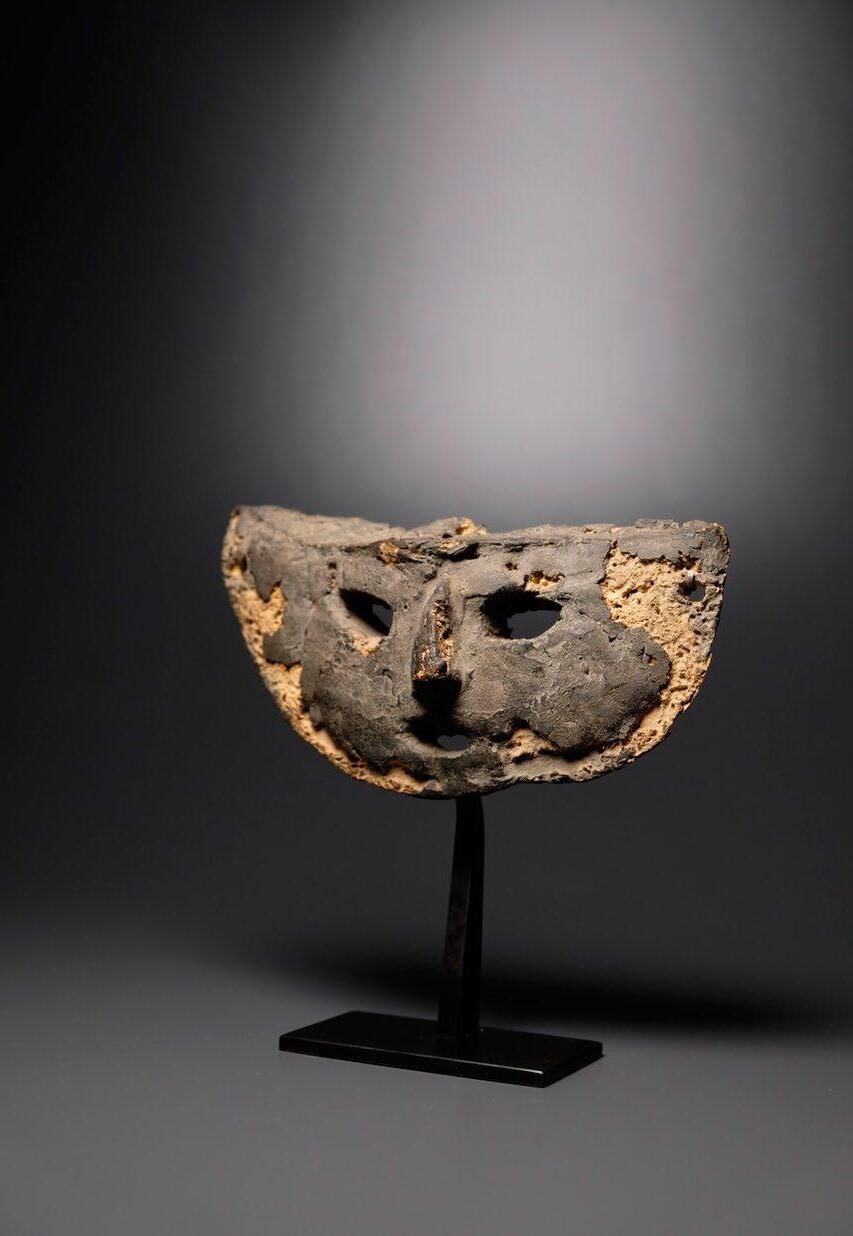
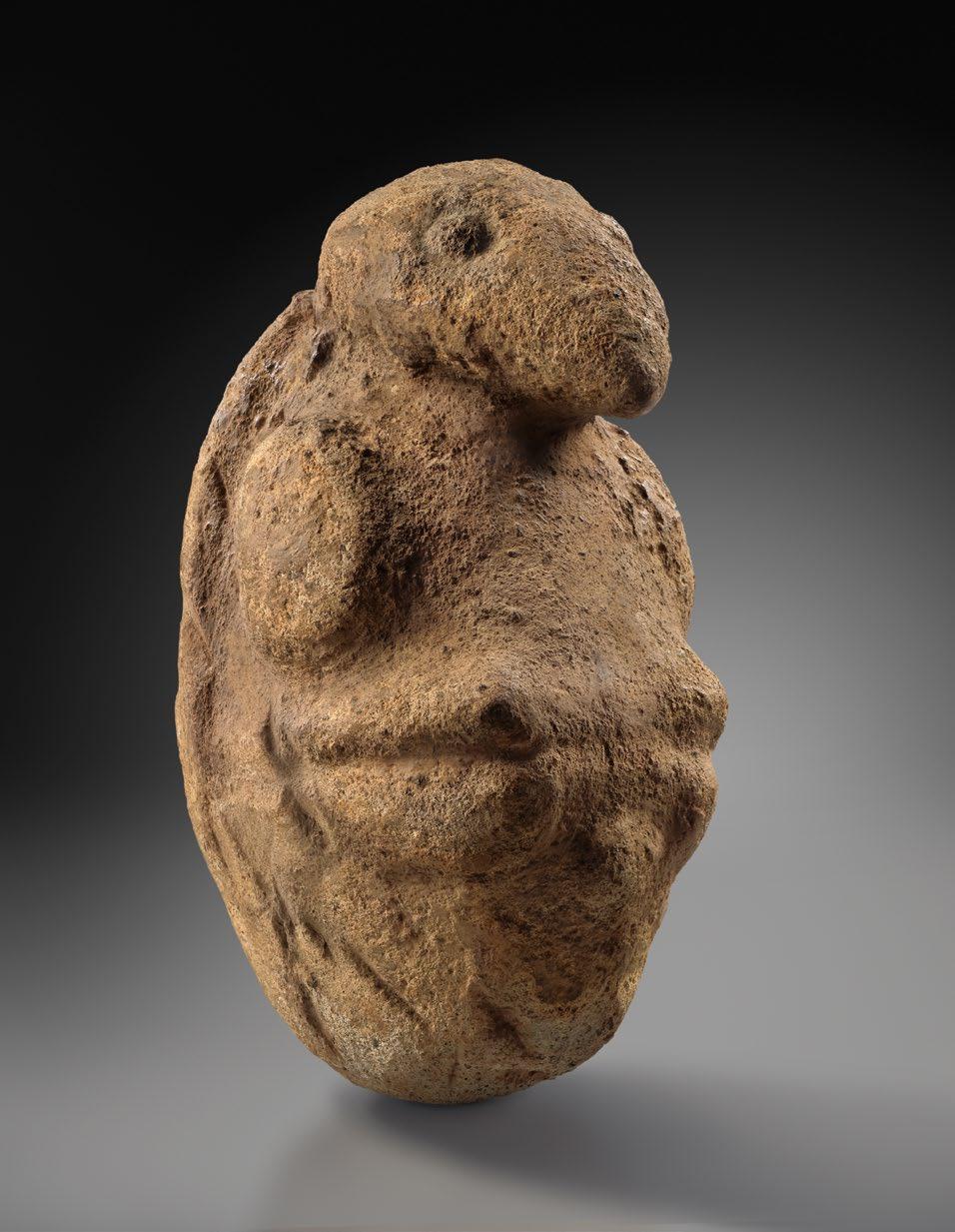
Crouching anthropo-zoomorphic archaic figure
Collected in the laiagam region, Enga Province, PnG, Melanesia. 4000 BC to 400 ad. 22 cm.
Medium hard sandstone with an archeological surface
7,3 x 4,5 cm
Provenance:
Collected in the field by ronald Ingle, australian Geologist with dawsett Engineering between 1961 and 1963 in Enga Province. Private collection
Price on request
O BJECT Pr ESE n TE d By:
anthony JP Meyer
M.: + 33 (0) 6 80 10 80 22
E.: ajpmeyer@gmail.com
W.: www.meyeroceanic.art
This enigmatic extremely rare figure might have served as a cult figure in relation to agricultural rituals of fertility and harvest. It was probably painted and used in some sort of sacred shrine or enclosure as a central deity from an earlier culture group and belief system that is as yet undeciphered.
It represents what appears to be the hybrid of a human figure with a long-nosed spiny echidna (or possibly a turtle in the present case) found in various typologies throughout the Central highlands and upper ranges surrounding the Sepik and ramu Basins.
v ETTE d By:


Gourd stopper
Makonde
Mozambique, Tanzania
height: 21,5 cm
Provenance:
French collection
Price:
Olivier Castellano
M.: +33 6 11 21 25 22
E.: info@oliviercastellano.com
W.: www.oliviercastellano.com
v ETTE d By:



OST
door post Mossi Burkina Faso
height: 45 3/8"
Provenance:
Thomas GB Wheelock collection
Publication:
land of the Flying Masks, art and Culture in Burkina Faso: The Thomas GB Wheelock Collection. #6 Munich/ Berlin/ london/ new york
Price on request
BJECT
Stephenson
M.: +1 646.644.7156
E: info@stephensonafricanart.com
W. : www.stephensonafricanart.com
v ETTE d By:


“Ah! Vanitas Vanitatum! Which of us is happy in this world? Which of us has his desire? or, having it, is satisfied? Come, children, let us shut up the box and the puppets, for our play is played out.”
William Makepeace Thackeray, Vanity Fair

Skull Japan
Circa 2018
hinoki wood (Japanese cypress), pigments and dry lacquer
human dimensions
Tomobako
Price: 9.000 euros
The work of Japanese sculptor k ikuchi Toshimasa is somehow bewilderingly obvious. Born in Ehime Prefecture in 1979 and trained in the restoration of Buddhist statues at the Tokyo University of the arts, where he obtained a doctorate in sculpture conservation and restoration in 2008, he uses his perfect mastery of the techniques of classical Japanese statuary to carve pure forms in wood – geometric, hydrodynamic or figurative.
O BJECT Pr ESE n TE d By:
Galerie Mingei
M: +33 (0)6 09 76 60 68
E: mingei.arts.gallery@gmail.com
W: www.mingei.gallery
v ETTE d By:
The notion of pure form applied to sculpture is by definition contradictory. Since sculpture is a mechanical process of shaping matter, it is doomed to imperfection and contingency, regardless of the degree of technical mastery the sculptor or the machine that often replaces him may have attained. The work of the hand, the accident fixed in a material are the norm, and from this point of view the history of the sculptural attempts of the 20th century to concretely objectify ideal forms drawn from mathematics is that of an illustrious succession of imperfect masterpieces. Unwilling to flee this problematic legacy, kikuchi on the contrary rises to the challenge of virtuosity. he stands against the prevailing trend in contemporary art, and his work remains that of a hand set in motion and nourished by sculptural techniques.
Beginning in 2010, the theme of the skeleton becomes ubiquitous in kikuchi's sculpture, and in a very literal way. an abundant series of skulls and bones carved of Japanese cypress (hinoki) and covered with lacquer is created, collectively titled Figurative Forms. The techniques of traditional statuary are used for the hyper-realistic rendering of an iconography radically alien to the Buddhist tradition – that of Western natural history and vanities. The Japanese cypress wood is carved in such a
way as to render the formal structure of the bone it is used to represent to perfection, while the lacquered surface reproduces the nuances of the original specimen with the greatest possible accuracy. For kikuchi, this abrupt change of repertoire was the logical fruit of an intellectual path. as a researcher at the University Museum, the University of Tokyo, he is in contact with its rich natural history collections on a daily basis, and found the springboard for a new direction for his sculptural activity in the formal perfection of animal and human osteological specimens. after having studied the architecture of Buddhist dakkatsu kanshitsu statues at length and in depth, he set directly to work on an investigation of the morphological aspects of the skeletons of living beings.
This new iconographic orientation brings about a twofold change in the question of figuration. On the one hand, from the point of view of the emotion aroused by the sculptural work, whereas the hieratic figuration of Buddhist statues calls for devotion and compassion, the cold representation of human or animal bones is fundamentally immanent. an educated eye will undoubtedly try to link
these pieces to the long artistic history of the vanity, but there are only bones, so to speak, confronting the viewer here. On the other hand, on the fundamental level of the aesthetic function of figurative works, where Buddhist statues derive their aesthetic authority from a religious foundation rich in well-established iconography, figurative representations of skulls and bones refer instead to a scientific relationship of objectification. It should be noted that in the teaching of medicine in Japan until the end of the Edo period, medical researchers commissioned Buddhist sculptors to produce wooden replicas for research and teaching purposes because of the Buddhist prohibition on the handling of human bones. It is a curious irony that the techniques of Buddhist statuary were thus used to circumvent a religious interdiction forbidding the handling and objectifying of bones. This gave rise to the Japanese tradition of mokkotsu ("wooden bones").
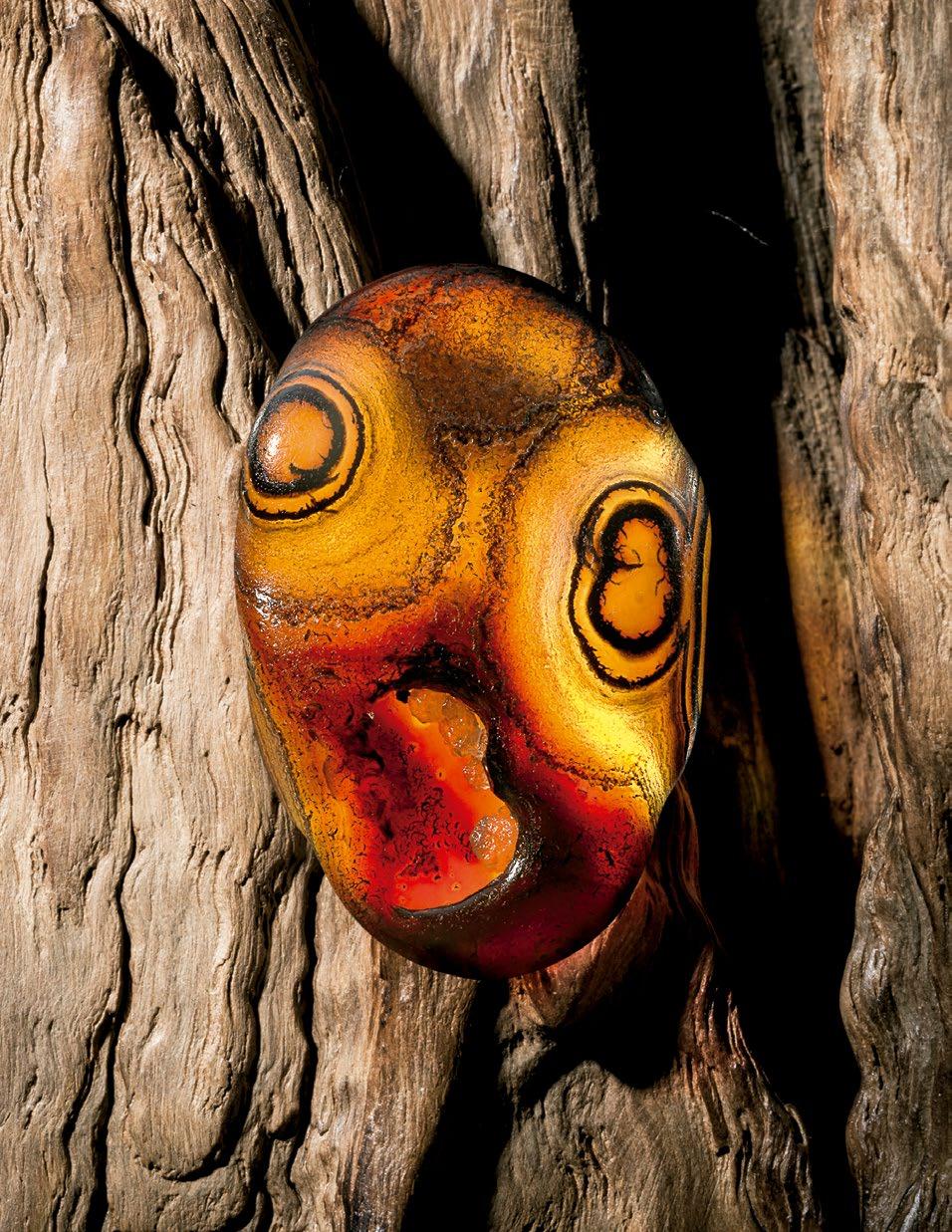
aG aTE PEBB
China length: 4,5 cm
Price on request
O BJECT Pr ESE n TE d By:
rasti Fine art ltd.
M.:+852 2415 1888
E.: gallery@rastifineart.com
W: www.rastifineart.com
a golden, honey-coloured and black agate pebble naturally formed as a ghost head with uneven eyes and open mouth.
v ETTE d By:
heads
Ekoi-Ejagham, Cross river, nigeria
Early 20th century
Wood, hide, pigments, metal, hair, rattan
height : 26 cm and 28 cm
Provenance:
English private collection
Price: 3.000 euros for the pair
These two Ekoi heads obviously endured the test of time together and today they tell a story that may be the story of their long life. While the two characters observe us, they also seem to have a dialogue (about us ?).
and though we observer, may think the time made them monstrous, one might see them as a mirror of our own monstrosity. If you look carefully, the yellow one has the word "God" written on the forehead. Is it the work of a zealous missionary? Is it from their time in the tribe? In the Uk? hard to tell but in that sense these two are truly marvelous.
M.: +33 (0)6 42791313
E: granierancient@gmail.com
W. : www.granierancient.com
v ETTE d By:



drunken skeletons
Signed: k ansetsu suiko heiga (Painted and inscribed by k ansetsu when drunk).
Seals: right: Ikken suito tenten shi (In the spirit of acute drunkenness feeling as if ascending to heaven) and left: k ansetsu
Japan
Taishō/Shōwa period
20th century hanging scroll, Ink on paper
Scroll: 195 cm x 49,5 cm
Painting: 122 cm x 30,5 cm
Exhibition: Enfers et Fantômes d'asie [Ghosts and hells: The Underworld in asian art], Musée du quai BranlyJacques Chirac, Paris, 10 april – 15 July
2018
Price: 3.600 euros
a paper kakemono (hanging scroll) painted in ink with two seated skeletons drinking sake and eating fish. One of them sitting with his back to us playing the shamisen (three-string instrument) while the other holds a fan aloft in a joyous manner.
awasebako (fitted box) inscribed:
label: k ansetsu, jinsei shinri (k ansetsu. Truth about life)
label: k ansetsu, gaikotsu sanzai (Skeletons spending money like water, by k ansetsu)
Inscribed: We are enjoying drinking, dreaming of flying and sleeping amongst the flowers, drinking merrily under the cherry blossoms, alas we feel dizzy – our eyes are swimming
hashimoto kansetsu (1883-1945). Given name: hashimoto kanichi. Gō (art name): kansetsu.
O BJECT Pr ESE n TE d By:
Gregg Baker asian art
M.: +32 468 00 56 85
E.: info@japanesescreens.com
W: www.japanesescreens.com
v ETTE d By:
a Japanese style painter k ansetu was born in kobe and worked in the k ansai area as a member of the second generation of the modern kyoto school. he first studied under Takeuchi Seihō (1864-1942) and went on to study the nanga style as well as ancient Chinese and Japanese painting. In 1921 he studied in Europe and made several trips to China. k ansetsu was a member of the art Committee of the Imperial household and of the Imperial art academy as well as being a frequent exhibitor at the Bunten (Fine arts Exhibition of the Ministry of Culture). In 1939 he received the asahi Culture Prize.
Works by the artist can be found in the collection of: kyoto City art Museum, kyoto; Metropolitan Museum of art, new york; Museum of Fine arts, Boston; national Museum of Modern art, kyoto; national Museum of Modern art, Tokyo; Tokyo University of arts Exhibition hall, Tokyo; yamatane Museum of art, Tokyo.
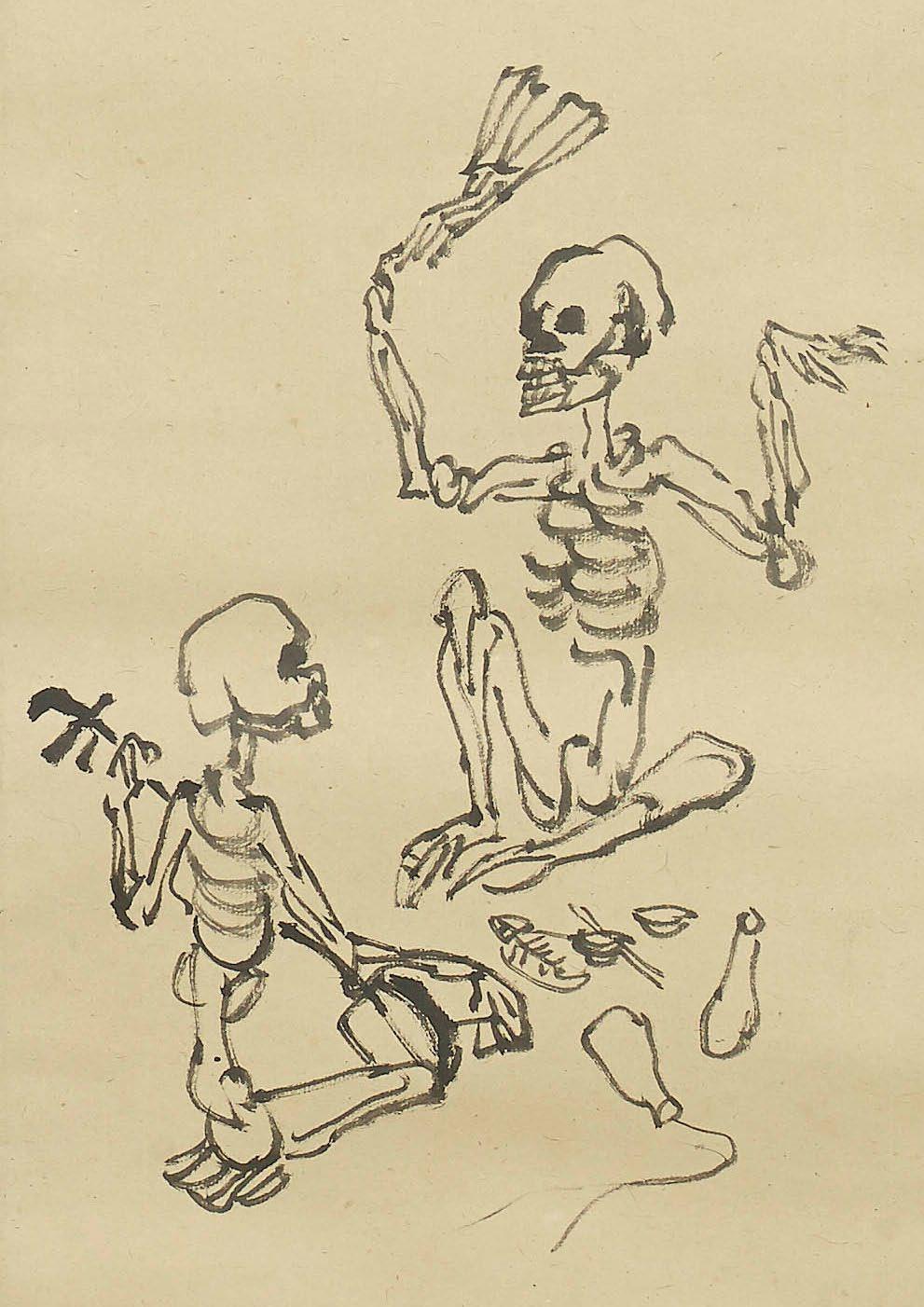


a kakemono (hanging scroll) with a seated skeleton and calligraphy
Signed by hyakunyo and Seals: Senkai
sambō (one thousand worlds, a room in a mountain),
Jihō, Ji
Japan
Edo period
18th century
Ink on paper
Scroll: 181 cm (h) x 30 cm (w)
Painting: 105,5 cm (h) x 27,5 cm (w)
Price: 3.200 euros
vow your devotion to Shakyamuni Buddha and amida Bodhisattva. you must not be frightened by the ebbing of k alpa (aeon) and the many Sufferings, nor should you wish for Ease and Comfort. Beware of the approaching threat of kataku (the Burning house) as no day passes in which smoke does not rise from bodies being cremated and burnt to ashes.
a Buddhist monk hyakunyo was born in Omicho, Shiga prefecture, and entered the Tendai sect complex on Mount hiei where he spent most of his adult life before returning to his home at Omi-cho. after his return he built a small temple, an important part of the local community. hyakunyo often painted for his supporters as a token of his gratitude. The inscription on this scroll refers to the kataku (burning house) otherwise known as the Three Carts and the Burning house parable, featured in the lotus Sutra.
O BJECT Pr ESE n TE d By:
Gregg Baker asian art
M: +44 (0) 20 7221 3533
E: info@japanesescreens.com
W: www.japanesescreens.com
v ETTE d By:
The main character in this parable is a wealthy old man who has many children living in an immense mansion. One day his house catches fire and quickly engulfs the whole building while all his children were playing inside totally absorbed by their game, unaware of the imminent danger approaching. Their father, who was outside the house, tried to warn them to come out at once but to little success; the children showed no understanding of the danger and continued playing. On his second attempt to save his children, the rich man lured them out by promising the three kinds of animal-drawn carts the youngsters had always wanted. he said he had goat, deer and ox-drawn carts waiting for them outside the house to play and that they should hurry out. hearing this they rushed out and escaped the fire. nevertheless, once his sons and daughters were outside the father presented each one of them with a cart of identical size, quality and greater value than the ones originally

promised. They were adorned with fine rare jewels, covered by canopies, lined with carpets and cushions; each carriage was drawn by a handsome and strong white ox attended by an array of servants. Buddha then asks his disciple if this father can be held responsible for lying to his children and not keeping his word, and they both conclude that it is agreeable to use white lies to awaken people and help them attain Buddhahood.
This parable is heavy with analogies and symbolisms.

Unsigned Japan
Meiji period
Circa 19th century
Japanese bamboo scholar wrist rest carved with skeleton trapped in a spider web
19,7 cm x 5,8 cm x 1,5 cm (h)
Stored in old wooden kiribako
Price: 3.500 euros
a rectangular wrist rest carved from a section of bamboo. The curved, convex surface is skillfully engraved with skeleton trapped in a spider web. The graceful design of shallow incising combines superbly with the smooth brown surface. It displays the artist's outstanding skill and the elegance of the bamboo.
Wrist rests are commonly found in a Chinese scholar’s studio and were used by bunjin people (Japanese literati) in the art of calligraphy to support the hand when writing with a brush, affording more freedom of movement than a hand resting on the paper or silk.
The bamboo, as material, was used for scholar’s objects for its symbolic meaning. In China, the confucians likened bamboo’s ability to bend without breaking to being a desirable virtue in a "junzi", a Chinese philosophical term often translated as "gentleman," "superior person",or "noble man." The term is frequently translated as "gentleman", since the characters are overtly gendered. however, in recent years, scholars have been using the term without the gender component, and translate the term as "distinguished person" or "moral person".
O BJECT Pr ESE n TE d By: Galerie
MingeiM: +33 (0)6 09 76 60 68
E: mingei.arts.gallery@gmail.com
W: www.mingei.gallery
v ETTE d By:


Mask
Winiama
Burkina Faso
Wood height: 72 cm
Provenance: Franco Monti, Milano Price on request
O BJECT Pr ESE n TE d By:
Joaquin Pecci
T.: + 32 477 43 94 12
E.: joaquin.pecci@skynet.be
W. : www.joaquinpecci.net
v ETTE d By:



archaic figurative food stirrer
Massim area, Papua new Guinea. 19th century
Stone carved kwila wood. height: 63,2 cm
Provenance: acquired at Christie's, new york, nov. 4, 1994, lot 53; Galerie Meyer, Paris; Marcia & John Friede, the JOlIka collection, rye, new york; Bruce Frank, new york. Price on request
The ancestor figure as the finial is carved in an archaic style with the elongated (or deformed ?) skull with a raised crest and a grinning mouth showing the teeth. The arms are held bent at the elbows with the curled stylized hands held high to the front (one missing). While the artist here remains yet to be identified it is absolutely certain that a Master-Carver of distinction sculpted this artwork.
O BJECT Pr ESE n TE d By:
anthony JP Meyer
M.: + 33 (0) 6 80 10 80 22
E.: ajpmeyer@gmail.com
W.: www.meyeroceanic.art
v ETTE d By:


Amida's unimpeded light is the sun of wisdom that destroys the mind of darkness.
Kentetsu Takamori, Preface in Teaching, Practice, Faith, Enlightenment

Standing amida Buddha Japan
k amakura or nambokuchō period
14th century
(Stand and mandorla, probably Edo period, 17th Century)
Gilt-lacquered wood, inlaid crystal eyes (gyokugan)
h 50,5 x W 16,0 x d 15,0 cm (overall)
Inv no. 22.008
Price on request
O BJECT Pr ESE n TE d By:
Galerie kommoss
M.: +49 177 6033 201
E.: info@galeriekommoss.com
W.: www.galeriekommoss.com
a guilt-lacquered wood figure of amida Buddha, standing on a high stand on a double-lotus pedestal in front of an elaborately decorated mandorla with swirling clouds and an abstract open-worked lotus flower highlighting his head. The figure shows a serene facial expression with half-opened eyes made of inlaid crystal eyes with painted pupils looking downwards in front of the figure.
The right arm raised and the left arm extended, both hands are opened with the palm to the viewer while the thumb and forefinger are forming a circle. With this specific hand position (mudrā), known as raigō-in, amida Buddha is leading and welcoming his faithful believers to his realm Sukhāvatī (also known as Western Paradise or Pure land) where they will be reborn after death in a pond of lotus flowers.
v ETTE d By:
devotion to amida was introduced around the 5th century from India to China from where it gradually spread to Japan. already known in Tendai Buddhism, where the invocation of amida Buddha’s name rose in popularity throughout the 10th century, the school owns formation in Japan did not take place before the 12th century. Based on the concept of salvation through faith alone, it was the former Tendai monk hōnen who established 1175 an own Buddhist cult of amida, called Jōdoshū or the School of the Pure land. By doing so, hōnen parted from the traditional sects whose complex rituals and time-consuming practices laid in the hands of aristocratic elite alone. By making the popular nenbutsu prayer “namu amida butsu” (meaning: “homage to amida Buddha” or “I take refuge in amida Buddha”) the central act of devotional practice, hōnen created a simple doctrine of salvation accessible to a broader part of the society that is still popular today.

The standing amida figure is a magnificent work, showing specific stylistic elements typical for statuary from the 13th and 14th centuries. a very similar figure made of metal can be found for instance in the national Museum of asian art (accession no. F1971.4a-b). Particularly noteworthy is the design of his garment’s folds, which are elegantly flowing down the Buddha’s body wrapping his legs in U-shaped lines. The folds are arranged in a way that they give the illusion of movement to the otherwise strictly still standing Buddha. They are additionally adorned with finely cut gold leaf with auspicious decors.

head
Siam/Thailand
ayutthaya period
16th/17th century
Bronze/Copper alloy
height: 33,5 cm, 50,5 cm with base
Provenance:
alexander gallery, nyC
Bernhardt Crystal 1914 - 2008
Price on request
O BJECT Pr ESE n TE d By:
Mark Eglinton
M.: +1 646-675-7150
E.: markeglinton@icloud.com
IG: @markeglintontribalart
v ETTE d By:



Japan late Meiji-period (1868-1912)
kutani porcelain
height: 45 cm
Price:
a late Meiji-period (1868-1912) kutani porcelain figurine of Gyoran k annon (“fish basket” iconography) wearing a gold necklace and bracelet. The robe is finely dotted with numerous white glaze drops and decorated with medallions of dragons in green, black, yellow and gold.
This bosatsu (bodhisattva) is based on a Chinese tale of the Tang dynasty in which Buddha appeared in a beautiful maiden’s figure, selling fish in a bamboo basket, and spreading Buddhism.
O BJECT Pr ESE n TE d By:
arie vos
M.: +32 476 87 85 69
E.: arie.vos@kitsune.be
W.:www.kitsunegaroo.com
v ETTE d By:
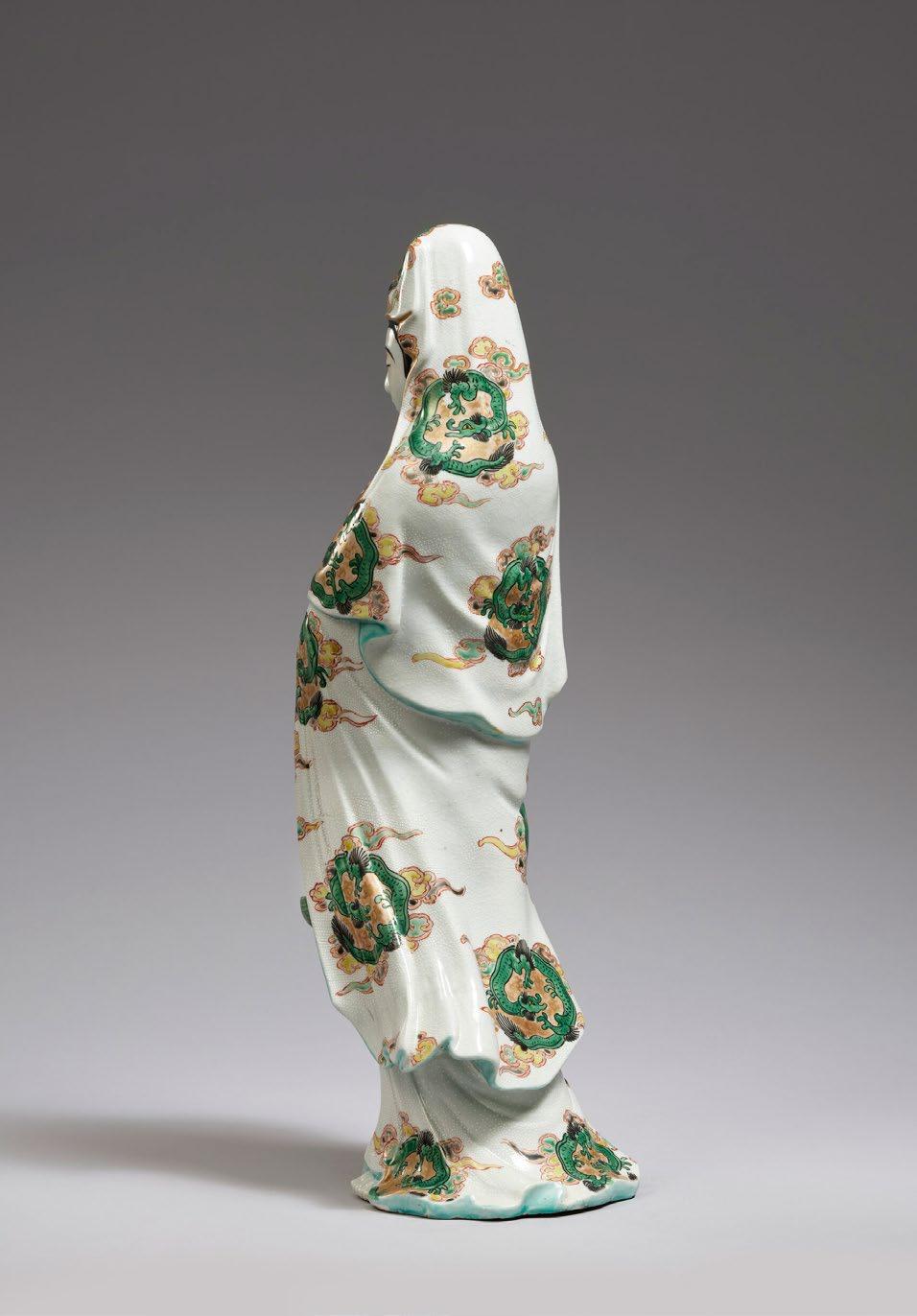

Japan
late Edo period
1860s
Ink and light colors on paper
h. 122,0 (30,9) x 69,7 (57,8) cm
Inv. nr. 19.041
Price on request
O BJECT Pr ESE n TE d By:
Galerie kommossM.: +49 177 6033 201
E.: info@galeriekommoss.com
W.: www.galeriekommoss.com
hanging scroll by Zen Master ashi kyōdō (1808-1895) with a painting of Jizō and Enma playing music together. Jizō and Enma are two antagonistic figures from the asian mythology. Enma, more associated with daoism and known in Chinese as yanluo, is the king of hell, who is understood as the judge and warden of the death. Jizō, instead, known in Sanskrit as kshitigarbha, is a Buddhist Bodhisattva often depicted as a common monk with Buddhist robes and shaved head. he is believed to be the savior of the souls, who helps the death to find their safe way into the afterworld. he is also able to travel to king Enma's empire to rescue kids and sinners from hell.
In this fantastic and profound painting, however, these two antagonistic figures are miraculously playing music together. kyōdō describes the scene in his inscription as follows:
Jizō and Enma playing music together on a flute and a lute. Both, heaven and hell took a day off to enjoy the music regardless of demons and saints. They really enjoy the time. a new wave of civilization comes over heaven and earth as it comes over the secular world. hanazono, given purple, written by kyōdō.
v ETTE d By:
In his inscription, kyōdō is using the expression bunmei kaika 文明開化, which can be translated as either 'enlightenment and opening' as well as 'developing cultural civilization'. It has been a central term used by the forces of the Meiji restoration in Japan. In the unstable political times of the late Edo period (1603-1868), the painting Jizō and Enma Playing Music Together is a wonderful symbol for both, the Zen Buddhist approach of the liberation of dual distinction as it is for overcoming the antagonistic political forces in late Edo and early Meiji period. It is therefore a wonderful symbol for pacification.

The depiction of Jizō playing a flute wearing an overturned lotus leaf on his head is an exceedingly rare and innovative portrayal that may have been created by k anō Tan’yū (16021674). The few similar paintings known of a flute-playing Jizō are by Tan’yū (for example in the MET or MIa) or his followers. none of the known examples are, however, paired with Enma playing a lute. Since the brushwork of the painting extremely fine and precise, it is most likely that this painting was not created by kyōdō himself but painted by a 19th century k anō school master as a remittance work for the famous Zen master.
ashi kyōdō, born 1808 in Izumi (today part of southern ōsaka province), has been a famous rinzai Zen monk of the late Edo and early Meiji period. he became 290th abbot of the Tōfukuji in 1877 and then 544th abbot of the rinzai school's main temple Myōshin-ji in 1889. died 1895.


a large polychrome carving of a tattooed Shan tribesman.
Burma Circa 1850
height: 84 cm
Price: 3.400 euros
O BJECT Pr ESE n TE d By:
adam Prout
T.: + 44 7725 689 801
E.: adam@adamprout.com W. : www.adamprout.com
v ETTE d By:

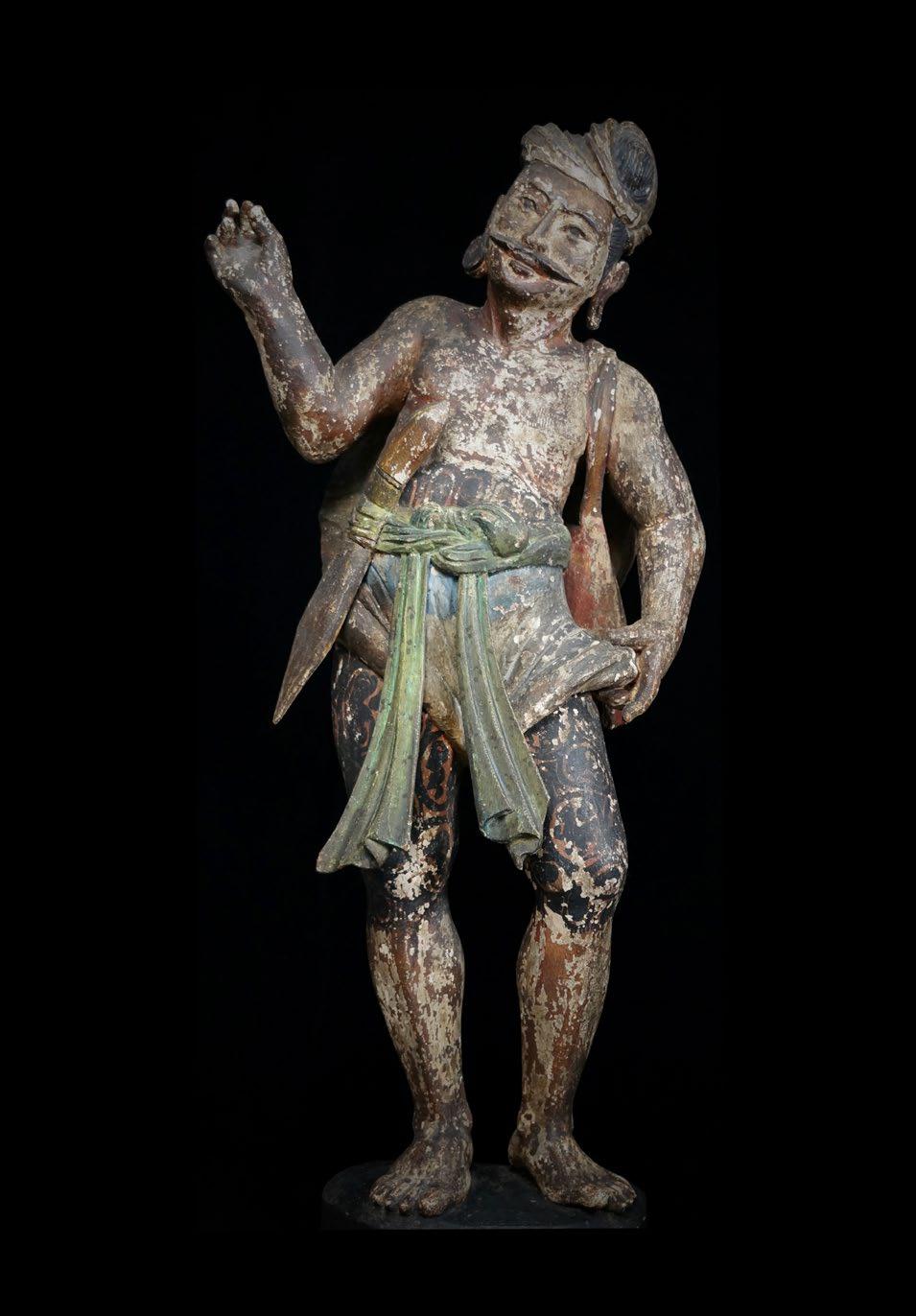
Canoe prow-board
Massim region, Trobriand islands, Papua new Guinea
19th - very early 20th century
Wood, pigments
height: 21 cm
length: 40 cm
Provenance:
French private collection
Price: 3.500 euros
In "argaunauts of the Western Pacific. an account of native Enterprise and adventure in the archipelagoes of Malanesian new Guinea" (london and Cracow, 1922), anthropologist Bronislaw Malinowski explains that during the first stage of making a canoe "which generally take two to six months, [...] the making of the prow-boards, the tabuyo (our small prow board) and the lagim (the transversal prowboard) is accompanied by specific spells and rites". In particular, the "k apitunena duku Spell" used by the Massim canoe carver says: "I shall wave them back (i.e., prevent all other canoes from overtaking me) [...] the prow skims the waves ; the ornamental boars leap, like dolphins ; the tubayo breaks the waves ; the lagim breaks the waves [...]"
The author also recorded an extraordinary belief in connection to the carved human figure laying on our canoe board. Called guway, it would "eat" the drowning men if not magically 'treated'. Specific long spells are hence recited over some ginger roots, on several occasions before sailing and during bad weather or shipwreck.
O BJECT Pr ESE n TE d By: laurent Granier
M.: +33 (0)6 42791313
E: granierancient@gmail.com
W. : www.granierancient.com
Upon close examination the reclining figure ont our prow indeed seems ambivalent in nature, with a smile going half way up and half way down, and one arm on the chest and the other one on the belly.
v ETTE d By:
The "plank" portion of our canoe board is also extremely important in Massim culture: It is an allusion to "the fish-hawk falling on its prey". That part depicts the idea that the canoe shall fall on the kula valuables and carry them off. according to Malinowsky this may be "an attempt to assimilate the whole canoe and all its parts to a fish-hawk falling on its prey, through the special meditation of the ornamental prow-board". Indeed, that image is clearly depicted with multiple birds falling from



the sky with an incredible sense of dynamism and movement.
That is to me the magic of Massim canoe art: With a few reading keys and explanations about symbols and colours, one can literally immerse him/her self into the kula adventure and live that moment which andré Breton famously described as "Oceanic art: the sky, the birds, the dreams"...
I was able to find another tabuyo with a reclining figure, but of a much lesser good quality, collected by Malinowsky in 1922 and now conserved at the British Museum (Oc,M.29).
The tabuyo is in excellent condition for its age and retains some good red, black and white natural pigments. I date it from the late 19th to very early 20th. It is mounted on a "Japanese style" wood base by romain laforêt.

Chief-k achina of the Guards
hopi
arizona, U.S.a.
Circa 1920-1930
Carved wood (cottonwood), feathers and pigments
height: 26 cm
Provenance: Charles M. nutt Sr collection, USa
Price on request
O BJECT Pr ESE n TE d By:
Julien Flak
M.: +33 6 84 52 81 36
E.: contact@galerieflak.com
W. : www.galerieflak.com
k achina dolls: they are the most beautiful things in the world…
Paul éluard, letters to Gala (1924-1948), p. 22
“k achina”: one word says it all!
For the hopi and Zuni people near the border between arizona and new Mexico in the american Southwest, “k achina” or “k atsina” (plural “k atsinam”) means wooden statuette, masked dancer or deity.
k achina dolls were given to children and constituted a pedagogical tool allowing them to familiarize themselves with the spiritual world and perpetuating knowledge of the founding myths on which their society was based.
Objects of tradition and of education, tools to remember and works of art in their own right, kachina dolls give vibrant testimony to the traditions and secret beliefs of native americans of the Southwest.
v ETTE d By:

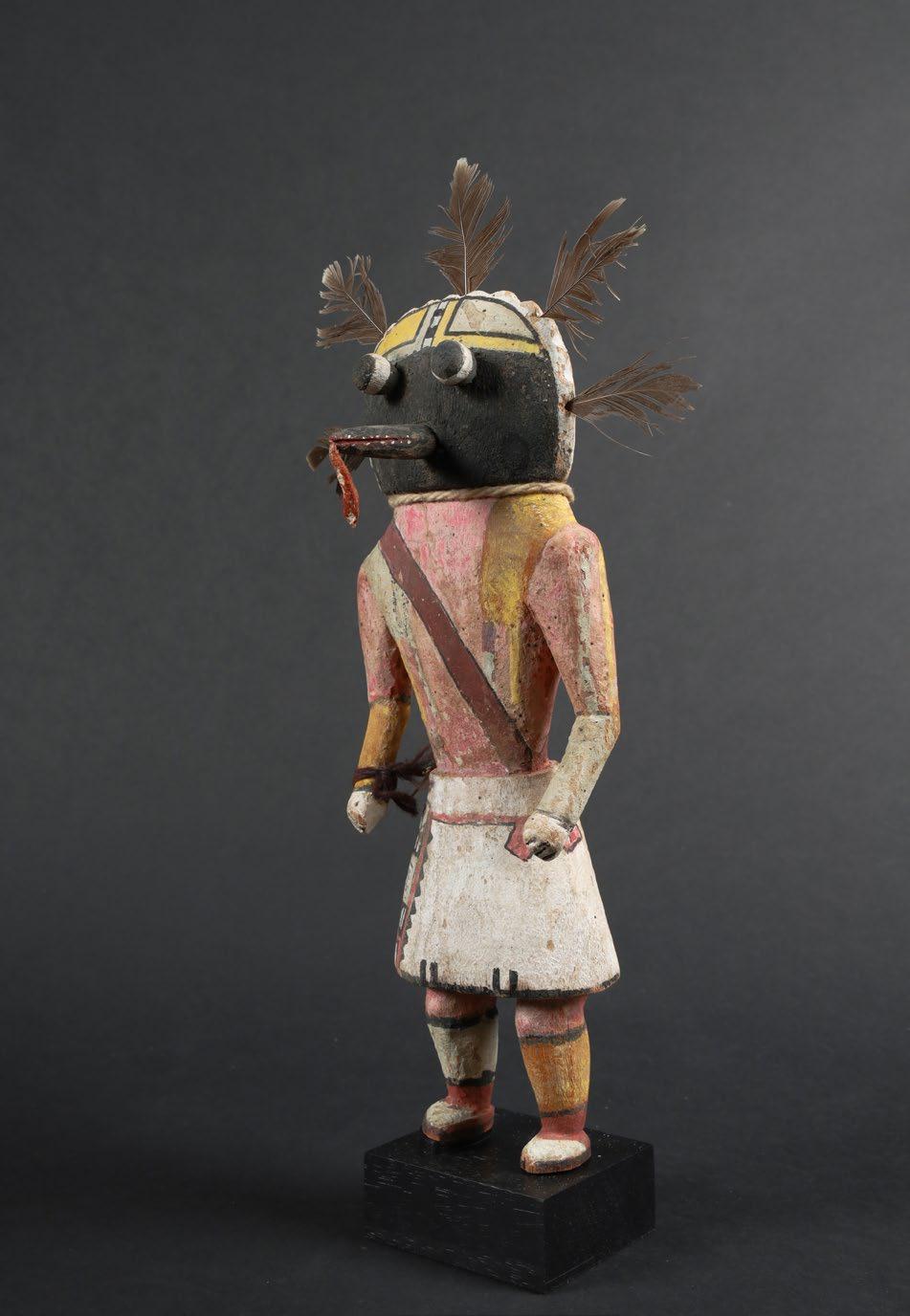

Japan
Meiji period (1868-1912)
Circa 1900
Glazed kiln-fired ceramic
height: 5 cm
diam.: 10 cm
Provenance:
american private collection
Price: 750 USd
The strange figure featured on this tea bowl is a yōkai, a Japanese term for a kind of spirit that can be mischievous, evil or helpful to human beings. This particular yōkai is shown in three different poses, alternating with three Japanese words, each formed by two Chinese characters. Underneath the Japanese words are three connected blue discs, which probably represent constellations.
The Japanese word visible here can be read as “haru-aki” or “shunjū,” meaning Spring and Fall, or months and years. another of the Japanese word can be read as “shūeki”, meaning divination. The images and words imply the passage of time in the cosmos, and the supernatural.
M: +1 646 753-4938
E: kennedyalan@hotmail.com
W: www.alankennedyasianart.com
v ETTE d By:



Tambu Gazelle Peninsula, Papua new Guinea
Tambu, Shell, wood and fiber diam.: 60 cm
Provenance: Chris Boylan, australia Price on request
O BJECT Pr ESE n TE d By: Mark Eglinton
M.: +1 646-675-7150
E.: markeglinton@icloud.com
IG: @markeglintontribalart
among the Tolai people of the Gazelle Peninsula in East new Britan, Papua new Guinea, shell money was and still is an important form of curency comprising of strings of shells. The purchase of tangible goods such as food, tobacco, etc is possible but it's real use is in cultural exchange, such as weddings, funerals, birthdays and feasts.
apart from establishing social status, the ultimate aim of accumulating shell money for a Tolai is the public distribution of tambu during funeral ceremonies. The spirit's access to the world of the ancestors depends on its wealth in tambu.
v ETTE d By:


a large Wooden egyptian Ushabti.
Statue new kingdom Egypt
lenght: 24 cm
Provenance: Private English collection since 1950’s
Price: 1.800 euros
O BJECT Pr ESE n TE d By: adam Prout
T.: + 44 7725 689 801
E.: adam@adamprout.com
W. : www.adamprout.com
v ETTE d By:



Statue yoruba nigeria
late 19th - Early 20th century
Wood, glass beads, metal
height: 29 cm
Provenance:
Private collection, France
Private collection, Italy
Price:
among the yoruba, twins called Ibeji were considered blessings and revered as supernatural beings. From the 18th century, Ere Ibeji statues contain the spirit of missing twins. Sculpted with great care, they are oiled, nourished, adorned with jewels as if they were a living being.
This old Ibeji twin figure will be part of my Winter 23 catalog, available online from January 18th.
O BJECT Pr ESE n TE d By:
Olivier larroque
T.: +33 (0)6 80 08 00 93
E.: o.larroque1@gmail.com
W.: www.olivierlarroque.com
v ETTE d By:

“She's mad, but she's magic. There's no lie in her fire.”
Charles Bukowski

Figure Pende
d.r. of the Congo
20th century
Wood with ochre-red patina, black pigment, vegetal fiber
height: 118 cm
Provenance:
Purchase from Galerie lecorneur
roudillon, Paris, 1963
Formerly in a private french collection
Price: 35.000 euros
Standing female ancestor figure with arms rendered apart from the body. her hands are resting on the hips on either side of the very prominent genitals. The head is turned lightly to the left. The fetish is wearing a rodent tooth necklace as well as bracelets, anklets and wristbands, and a fiber loincloth. an application of resin covers the neck and the space between the breast. The coiffure is made of vegetal fibers and rooster feathers.
O BJECT Pr ESE n TE d By:
laurent dodier
M.: + 33 6 08 22 68 15
E.: laurentdodier@wanadoo.fr
w. : www.laurentdodier.com
v ETTE d By:
IllUST raTIO n TO T h E
dE v I MahaTM ya: k al I
W IT hdraWS F r OM vIS hn U
Jaipur, India
Circa 1800
Opaque watercolor heightened with gold on paper
Image: 28,9 cm x 19,1 cm
Folio: 29,8 cm x 19,7 cm
Provenance: Private French collection Price on request
The present scene depicts the first episode of the devi Mahatmya during the time of pralaya, the period between the cyclical destruction and creation of the universe when the primordial ocean is all that exists. vishnu is depicted in deep sleep amongst the cosmic waters while Brahma prepares to create the next universal cycle. Brahma’s efforts, however, are interrupted by two demons who emerge to kill him. alarmed, he attempts to awaken vishnu to slay the demons, singing a hymn of praise. Brahma sings to the great goddess Mahamaya, the personification of vishnu’s sleep, and asks her to release him from her spell. as devi proceeds to retreat from vishnu’s body she appears before Brahma. vishnu then awakens and slays the demons, thereby acting as devi’s instrument in restoring cosmic order.
O BJECT Pr ESE n TE d By: k apoor Galleries
M.: + 1 (212) 794-2300
E.: info@kapoors.com
W: www.kapoors.com
v ETTE d By:
here, devi appears in her form as the tenheaded dasa Mahavidya Mahakali. This form of the goddess is relatively rare in the Indian painting tradition, as she is more commonly portrayed in her one-headed, four-armed image, trampling Shiva. however, the present form shares many iconographic attributes with the more common form. Clad in a garland of severed heads and skirt of dismembered arms, kali holds items representing the powers of each of the gods in her ten hands: a severed head, trident, bow, mace, conch, sword, and chakra. her outstretched tongues, bared teeth, long unruly hair, large nimbus and strong stance convey her fierceness. Below, vishnu reclines, and Brahma emerges from vishnu’s navel on a lotus, flanked by the demons Madhu and kaitabha. Fine lines of water and lotuses comprise the cosmic ocean, while a horizon of foliage bisects the background with a pale blue-grey sky above. This partitioning of the background reinforces the hierarchical scale of the painting and thus emphasizes kali’s great power.

Jaipur, India
Circa 1800
Gouache heightened with gold on paper 27,9 cm x 20,3 cm
Provenance:
Private collection, by 1977
Exhibition:
lycoming College Gallery; Pennsylvania, 1981
Price on request
While k ali is commonly known as the goddess of death, this classification is misleading. despite her violent tendencies, she is often associated with sexuality, and serves as a symbol of motherly love. Inextricably linked with shiva the destroyer, she is considered to be his consort and Shakti (power). k ali requires Shiva to calm her bloodthirsty inclinations, while in turn she provokes his destructive nature.
here, k ali is shown in an archetypal scene standing over Shiva. after she had become insatiable with bloodlust, she went on a killing spree harming innocents, until the gods asked Shiva to intervene. he laid among the corpses of her victims and upon realizing that she was standing over her celestial partner, she was ashamed and returned to her original form. The imagery has a deeper meaning, however, representing the eternal triumph of nature over man; even a powerful force like lord Shiva is obsolete without his Shakti (k ali).
O BJECT Pr ESE n TE d By:
k apoor Galleries
M.: + 1 (212) 794-2300
E.: info@kapoors.com
W: www.kapoors.com
v ETTE d By:


a comparable painting is kept in the collections of los angeles County Museum of art (inv. n° M.81.206.8).
k al I T ra MP l I n G O n
Sh I va nepal
18th century Pigments and gold on paper
height Page : 42 / Miniature : 39
Width Page : 29 / Miniature : 25,5 cm
Price: 8.000 euros
O BJECT Pr ESE n TE d By:
alexis renard
T.: + 33 1 44 07 33 02
E.: alexis@alexisrenard.com W: www.alexisrenard.com
v ETTE d By:

Standing female sculpture
Mama nigeria
Wood, sacrificial patina
height: 37,5 cm
Provenance:
allen davis collection, USa before 1990
Price:
O BJECT Pr ESE n TE d By: adrian Schlag
T.: +34 617 666 098
E.: adrian@schlag.net
W.: www.tribalartclassics.com
v ETTE d By:
“My armor is like tenfold shields, my teeth are swords, my claws spears, the shock of my tail a thunderbolt, my wings a hurricane, and my breath death!”
J.R.R. Tolkien
Protective figure
Bali, Indonesia 19th - Early 20th century Wood, pigment height: 61 cm
Provenance: Private Chinese collection Price on request
The term singa comes from the Sanskrit word for lion and is associated with the virtues of power, protection, strength and loyalty. They resemble tigers, indigenous to Bali until they became extinct a century ago. This is an extraordinarily fine example, with great color and attention to detail. It clearly was made under royal patronage.
O BJECT Pr ESE n TE d By: Thomas Murray
M.: + 1 415.378.0716
E.: thomas@tmurrayarts.com
W. : www.tmurrayarts.com
v ETTE d By:



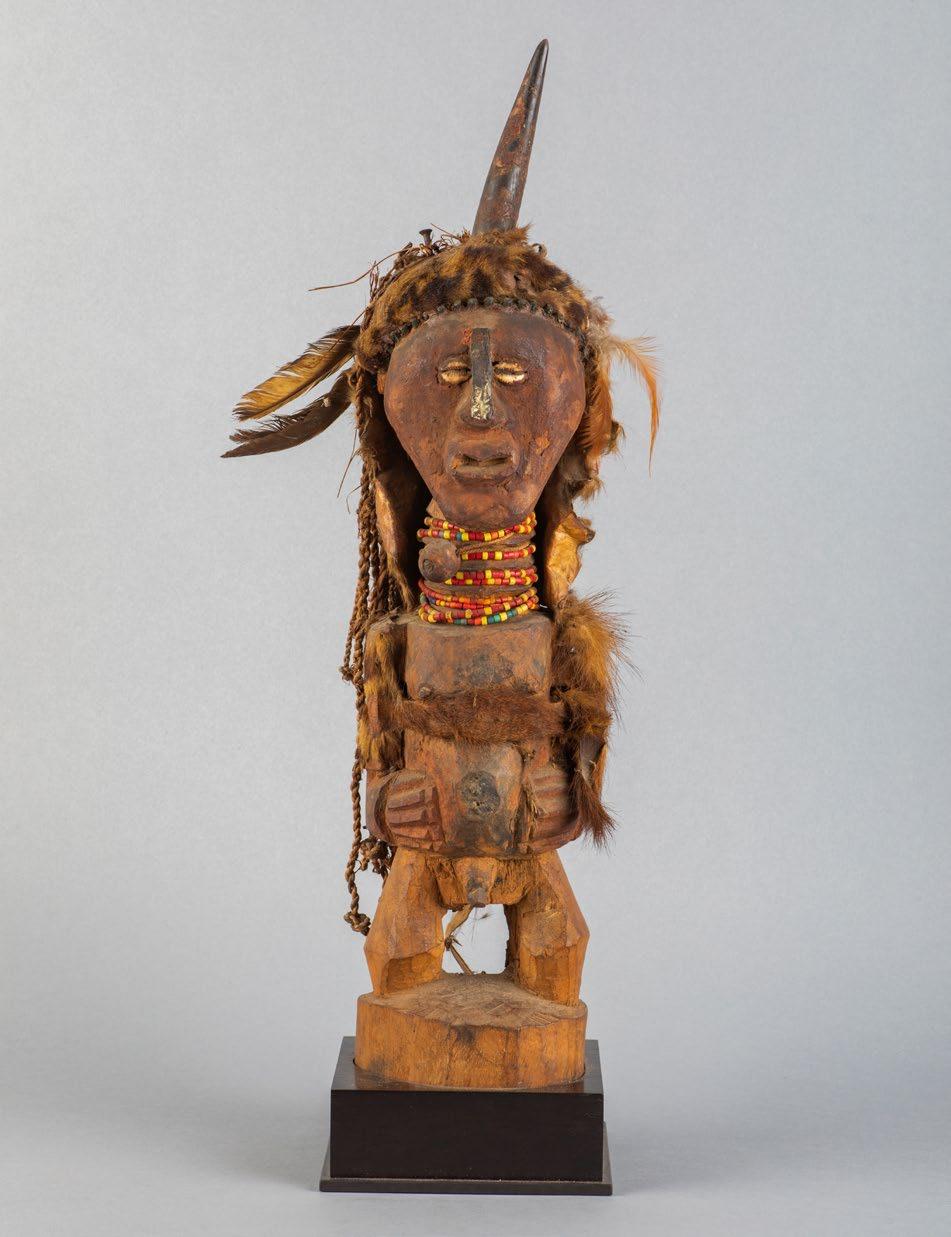
Sculpture
Songye
d.r. of the Congo
20th century
Wood, magic charge
height: 57,5 cm
Provenance:
Galerie lepage, Brussels (60s)
Price: 7.500 euros
Fetish fiure represented standing on a circular base, the hands resting on the abdomen. The head is large with an open mouth. The eyes are cowries. The nose is covered with a copper plate. The fetish wears a necklace made of trade beads. a horn is attached to the top of the head. The head and body are laden with leopard skin, feathers, plant fibers, nails and seeds.
These fetish statues derive their power from magical substances called bishimba inserted into their abdomens and heads. Materials such as hair, shells and skins increase this power.
O BJECT Pr ESE n TE d By:
laurent dodier
M.: + 33 6 08 22 68 15
E.: laurentdodier@wanadoo.fr
w. : www.laurentdodier.com
v ETTE d By:


Japan
Muromachi period (1336 – 1573)
Wood height: 19,05 cm
Price on request
O BJECT Pr ESE n TE d By:
Brandt asian art
M: +44 (0)7774 989 661
E: brandt@nildram.co.uk
W: www.brandtasianart.com
a rare, lacquered wood, carved in block form, model of a kneeling mischievous Oni with one horn and inlaid glass eyes. The overall patina is in a dark incense-stained colour. The popular demon is generally considered to be of foreign origin, although malicious and cruel they can be converted to Buddhism.
v ETTE d By:



Cambodia angkor vat or Bayon period late 12th-13th century
Bronze cast by the lost wax method
28 cm (h) x 19 cm (w)
Weight: 2 kg
Provenance: Private collection Milan, Italy
Gallery hachmeister Münster collection
detailed and openwork bronze fitting, part of a palanquin, that was used for transport by the khmer during the 12 and 13th centuries.
Garuda figures with spread wings (half man/ half bird, vehicle of vishnu) and naga rise up from a bunch of lotus leaves. The hook ends in the shape of an adorned deity, holding a naga with her two hands.
The hook has a socket through which the wooden palanquin rod was inserted. Traces of iron oxidation testify to an iron ring inside that was added to strengthen the hook.
The palanquin hook would have been attached to a cloth piece that formed the palanquin seat in which people of high esteem have been carried.
The bronze has been cast by the lost-wax process.
The lively aspect of the hook is indebted to the movement of the figures, the Garuda figure, the elaborate lotus decoration, all well placed in a balanced composition. The hook is in a good state of conservation with a wonderful green brown patina.
O BJECT Pr ESE n TE d By:
Farah MassartM.:+32 495 289 100
E.: art@famarte.be
W: www.famarte.com
khmer royalty and aristocracy were carried in wood and wicker palanquins which were typically suspended from a transverse carrying pole with decorative bronze hooks.
v ETTE d By:

Shishi (lion dog) okimono
Japan
1940
Tomobako
height: 21 cm
length: 27 cm
Price: 2.400 euros
a powerful bronze lion dog made by Sukenojo Terahata. It comes with the original storage box (tomobako), dated spring 1940. This bronze was made during the second Sino-Japanese war (1937-1945). very few bronzes from this period survived.
O BJECT Pr ESE n TE d By:
arie vos
M.: +32 476 87 85 69
E.: arie.vos@kitsune.be
W.:www.kitsunegaroo.com
v ETTE d By:


Bali
19th to early 20th century Cotton, crushed mineral pigments
86 cm x 65 cm
Provenance:
Ex.Joseph Fischer collection
Price: 8.000 USd
The Garuda is a mythic bird of great size and power and serves as the mount of the hindu deity vishnu. known to have stolen waters of the elixir of life to save his mother, the Garuda is greatly venerated in Bali as brave and with a good heart and yet forever in a battle with his serpent enemies, the nagas. This relatively large-scale Garuda depiction is particularly rich in iconography, and is painted on both sides of the canvas in an early k amasan style with crushed mineral pigments. Joseph Fischer wrote extensively on Balinese art and Indonesian textiles.
O BJECT Pr ESE n TE d By:
Thomas Murray
M.: + 1 415.378.0716
E.: thomas@tmurrayarts.com
W. : www.tmurrayarts.com
v ETTE d By:
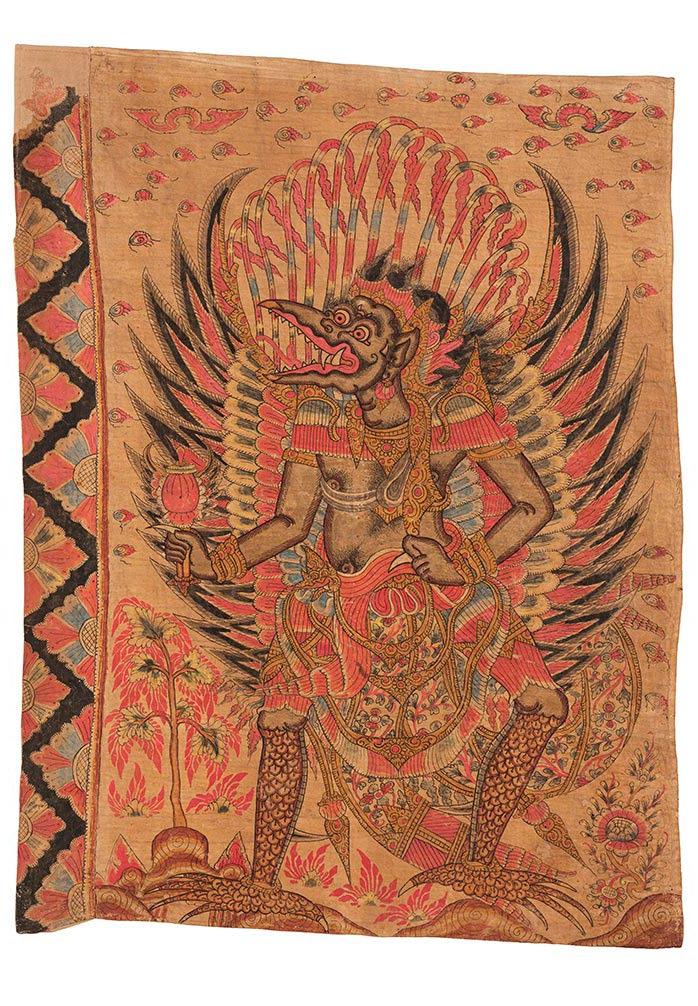


ya M a d har M ara J a
Sino-Tibet
18th-19th century
Bronze height: 25,4 cm
Provenance:
Wilhelm k åge (1889-1960) collection, Sweden
krook Family collection
Price on request
O BJECT Pr ESE n TE d By:
k apoor Galleries
M.: + 1 (212) 794-2300
E.: info@kapoors.com
W: www.kapoors.com
The lawyer Sten krook (1920-2009) and his mother Xenia krook (1892-1988) shared a common interest in travelling and collecting asian bronze figures. They conducted several journeys together to China, India, nepal, hong kong and Thailand, during 1930-80's. The collection is an interesting mixture of religious figures from the 15th to 20th centuries, from China, Tibet, nepal, India and Japan.
Striding in alidhasana on a buffalo over a prone human figure on a lotus base with his hands extended out to his sides, adorned with beaded jewelry, a garland of severed heads, the face ferocious with the mouth open and tongue extended, the flaming hair topped by a skull tiara, yami astride his leg offering a skullcup in her left hand, wearing an animal skin on her back, her face with wrathful expression, a consecration chamber open on the verso of the primary figure, with traces of polychromy on the heads of both figures and the buffalo. Based on Pala period style bronze work, the deity on the present figure can be compared with an eighteenth century figure of Ekavira Bhairavajra, which displays similar modeling particularly of the head and jewelry (U. von Schroeder, Indo-Tibetan Bronzes, 1981, p.p.472473, fig.130c). Compare the bull mount with a similarly rendered sow, see U. von Schroeder, uibid, p.p.488-489, fig. 138E.
v ETTE d By:
This beautifully cast figure features yama dharmaraja, striding in alidhasana on the back of a buffalo over a prone figure on a lotus base. yama is adorned with beaded swags, trampling a bull who in turn is crushing a woman with a blissful expression upon her face. yama’s right arm is raised holding the skull club, his left displaying karana mudra. he is draped with festoons, ribbons, and a garland of severed heads. Wrathful in appearance, he has the head of a bull, three round eyes, and sharp horns entwined with flame. his powerful torso is coiled
with a snake and festoons interlinked through central chakras. The present example features original scrolls housed within the figure.
yama dharmaraja, sometimes known as k alarupa, is a wisdom deity protector of the father class of anuttarayoga Tantra used by those who practiced vajrabhairava tantras found in all the Sarma Schools. The Gelugpa tradition holds yama dharmaraja in a special regard as one of the three main dharma protectors, with the others being Shabdhuja Mahakala and vaishravana. a common misconception, yama dharmaraja is not the same being as yama the ‘lord of death’ depicted as the central figure in Buddhist depictions of the hell realms, but instead is an incarnation of Manjushri who serves as the defeater of death.

nepal
18th century Pigments and gold on paper
height Page : 42 / Miniature : 39
Width Page : 29 / Miniature : 25,5 cm
Price: 8.000 euros
Bhairava with eight arms, is standing in a mandorla of fire, holding a kapala, a bow, a shield, a damaru drum, an axe, a sword, arrows, and a trident. above his head, we can see two cranes in flight.
Many different myths are associated with the figure of Bhairava. he is the terrifying form of Shiva, who cut off Brahma's head, which is why Bhairava is often depicted holding Brahma's head. In other episodes, Bhairava was born from Shiva's union with kali's divine wrath in his fight against the demon dahurasuran.
a comparable painting is kept in the collections of los angeles County Museum of art (inv. n° M.81.206.7).
O BJECT Pr ESE n TE d By:
alexis renard
T.: + 33 1 44 07 33 02
E.: alexis@alexisrenard.com
W: www.alexisrenard.com
v ETTE d By:
« What a Chimera is man! What a novelty, a monster, a chaos, a contradiction, a prodigy! Judge of all things, an imbecile worm; depository of truth, and sewer of error and doubt; the glory and refuse of the universe. » Blaise Pascal

Sculpture Burma Wood height: 108 cm Price on request
This kind of iconography is extremely rare.
O BJECT Pr ESE n TE d By:
renaud vanuxem
M.: +33 6 07 11 50 60
E.: rvanuxem@yahoo.fr
W. : www.renaudvanuxem.com
v ETTE d By:


Mask Sepik
Papua new Guinea
Wood height: 44 cm
Price: 1.800 euros
O BJECT Pr ESE n TE d By:
Pablo Touchaleaume
M.:+33 (0)6 89 90 75 70
E.: pablo.touchaleaume@hotmail.fr
W.: www.pablotouchaleaume.com
v ETTE d By:



China 1820-1880
lapis lazuli
length: 2 ¾” (7 cm) (excluding the stopper)
Provenance:
david Chang, San Francisco, Ca.; acquired from kenneth Brown, la Jolla, Ca. January 25, 1978
Price on request
O BJECT Pr ESE n TE d By: Clare Chu asian art llC
M:+ 1.310.980.4084
E: clarechuasianart@gmail.com
v ETTE d By:
a lapis lazuli snuff bottle, well-hollowed, carved in the form of a kylin reclining with its four paws tucked underneath its body, with its tail lying over its hind flanks and its ears flat against its head.
lapis lazuli has been mined in the remote Badakhshan Province of northeastern afghanistan for over 6,000 years and was brought into China along the Silk road. as a stone it was extremely important to Buddhism both for its bright color and its healing effects. It is highly symbolic of that which is sacred, pure or rare and is the given color of the principal Medicine Buddha. In one of the major sutras concerning this Buddha, Shakyamuni tells his close disciple ananda:
I beseech you, Blessed Medicine Guru, Whose sky-colored, holy body of lapis lazuli Signifies omniscient wisdom and compassion
As vast as limitless space, Please grant me your blessings.
Mask kono
Bambara
Mali
Wood, animal horn, crusty patina
height: 40 cm
Provenance:
Jean-Michel huguenin, Paris
Private collection, Paris
Price: 2.800 euros
O BJECT Pr ESE n TE d By:
Pablo Touchaleaume
M.:+33 (0)6 89 90 75 70
E.: pablo.touchaleaume@hotmail.fr
W.: www.pablotouchaleaume.com
v ETTE d By:



China
Six dynasties (220–581)
height: 4.5 cm
Provenance:
desmond Gure collection (1906–1970)
kirknorton collection
Carter Fine art ltd
Michael Gulbenkian collection
Publication:
Morgan and li, Naturalism & Archaism: Chinese Jades from the Kirknorton collection, no. 9
Price on request
O BJECT Pr ESE n TE d By:
rasti Fine art ltd.
M.:+852 2415 1888
E.: gallery@rastifineart.com
W: www.rastifineart.com
a speckled brown, grey and pale celadon jade model of a mythical beast, sitting upright and looking directly ahead, holding a rattle in the right hand and grasping a rosary in the left, the animal with two large rounded indented eyes, wide nose and long beard, the back of the head with two long horns curling to the shoulders, the stone of pale white to the interior covered in brown and grey streaks.
For another similar animal also date Six dynasties see Morgan and li, Naturalism & Archaism: Chinese Jades from the Kirknorton Collection, no. 10; one from the same period in lefebvre d’argence, Chinese Jades in the Avery Brundage Collection, pp. 68-69, pl. XXvII; a further jade beast from the Gerald Godfrey Collection dated Tang to Song dynasty in Palm Springs desert Museum, Magic, Art and Order: Jade in Chinese Culture, p. 110, no. 114; a deep russet jade dated the Tang dynasty in Ching and nien, Antique Jade Collections, p. 90, no. 112; and a further example in r awson and ayres, Chinese Jades Throughout the Ages, pp. 71 and 123, no. 194.
v ETTE d By:


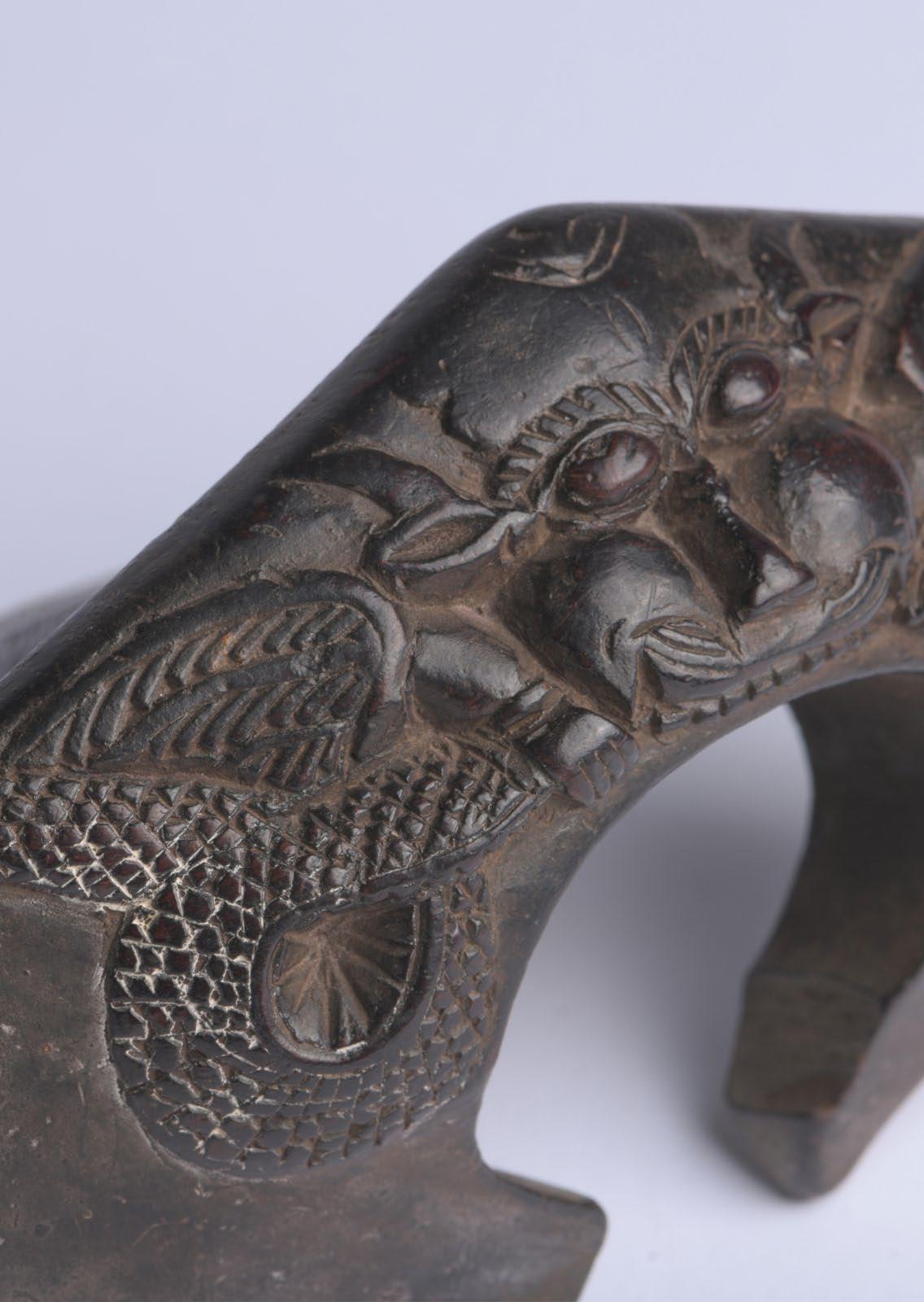
archer's Bracelet k athmandu, nepal 19th century
Wood
6 1/4" (w) x 3 1/2" (h) x 5 1/4" (d)
Price: 2.400 USd
This archer's bracelet has a powerful image of the newari deity chhepu.
O BJECT Pr ESE n TE d By:
Joe loux
T.: +1 505 695 6626
E.: joe@joeloux.com
W. : www.joeloux.com
v ETTE d By:
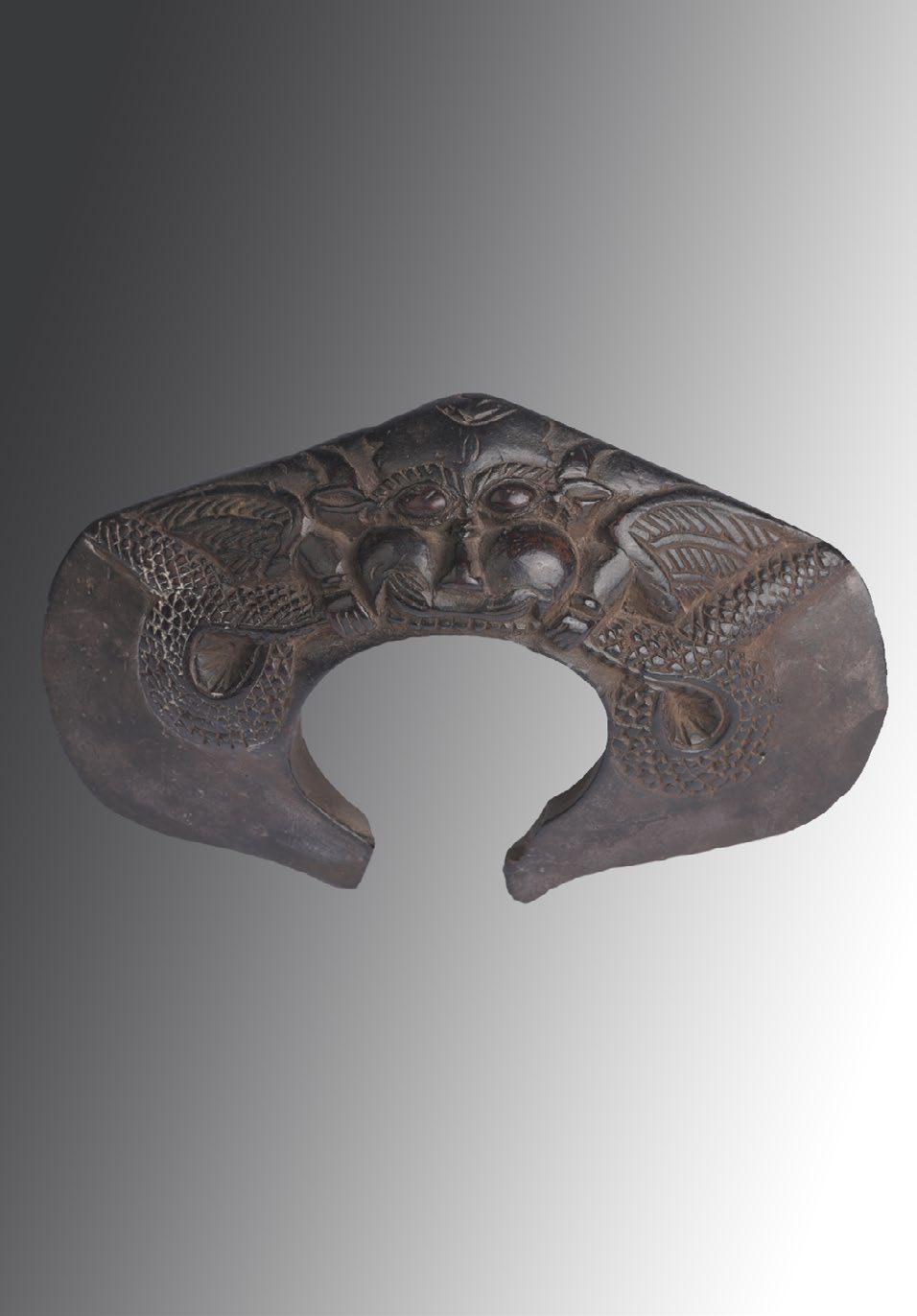
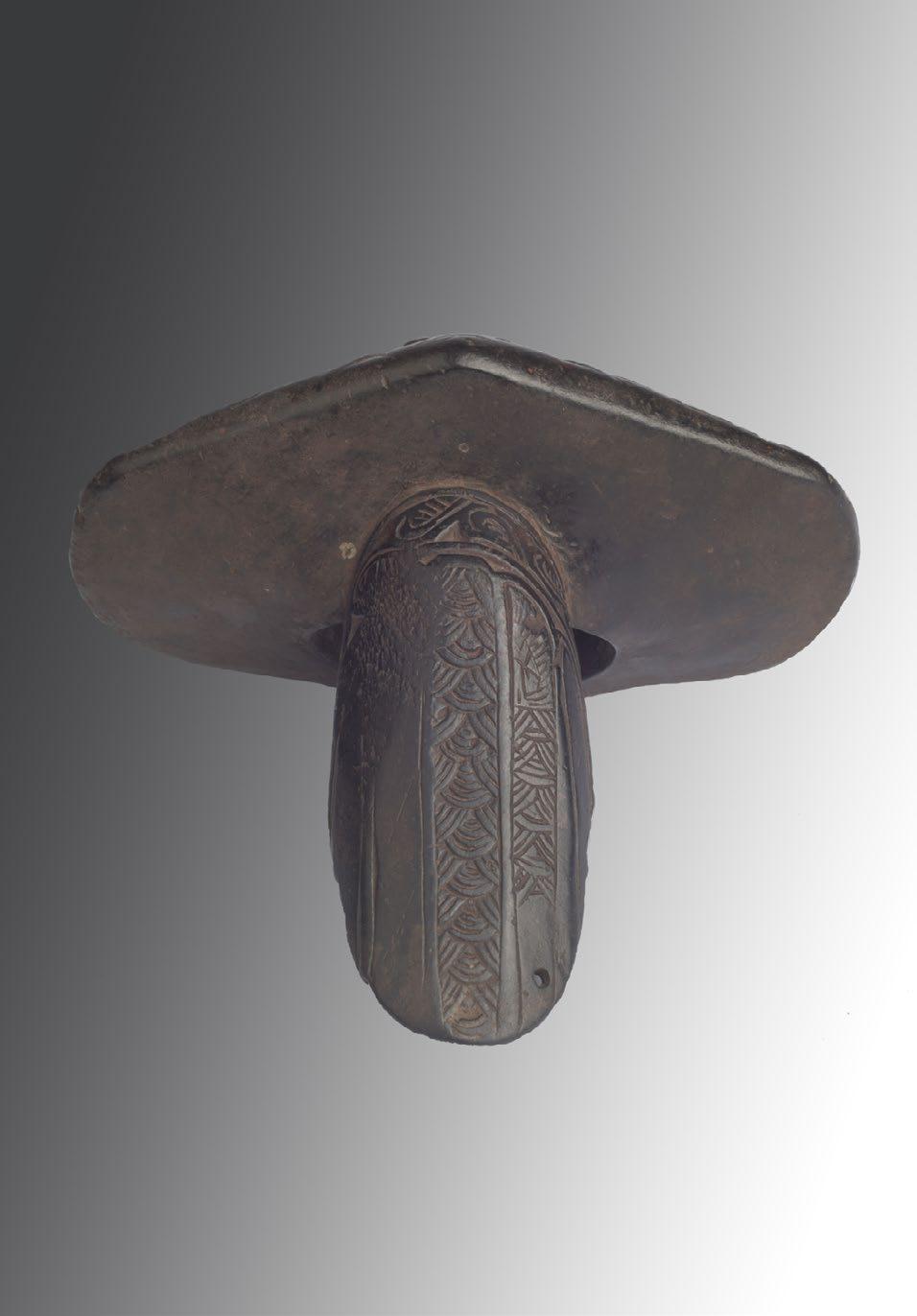
Pipe
Bamileke
Cameroon
Terracota
height: 26 cm
Provenance: Franco Monti Price on request
O BJECT Pr ESE n TE d By:
Joaquin Pecci
T.: + 32 477 43 94 12
E.: joaquin.pecci@skynet.be
W. : www.joaquinpecci.net
v ETTE d By:

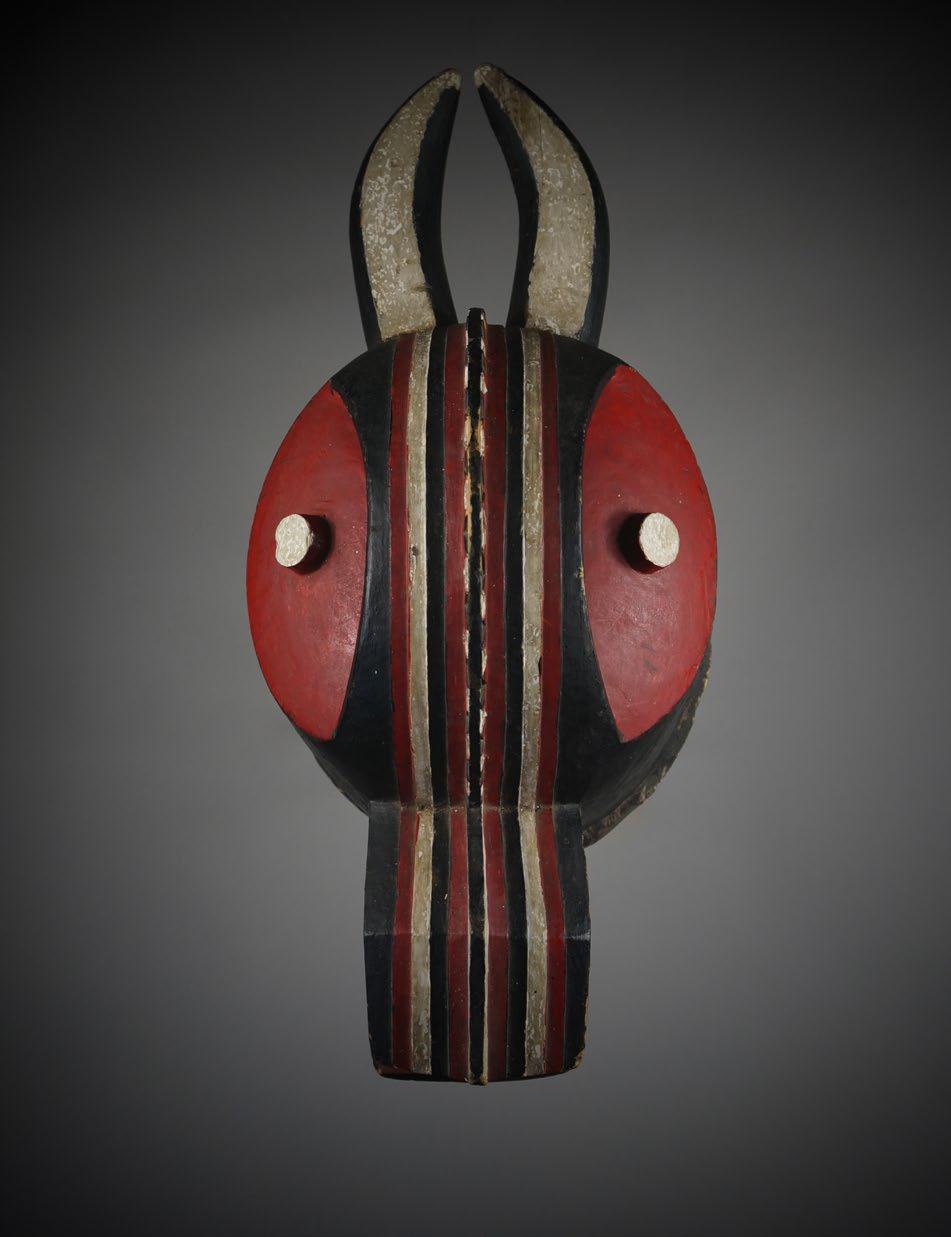
This mask represents a bush spirit and ‘wild nature’.
Mask Baule Ivory Coast Mid 20th century
65 cm x 33 cm
Provenance: Belgian collection
Price: 1.800 euros
O BJECT Pr ESE n TE d By: adam Prout
T.: + 44 7725 689 801
E.: adam@adamprout.com
W. : www.adamprout.com
v ETTE d By:


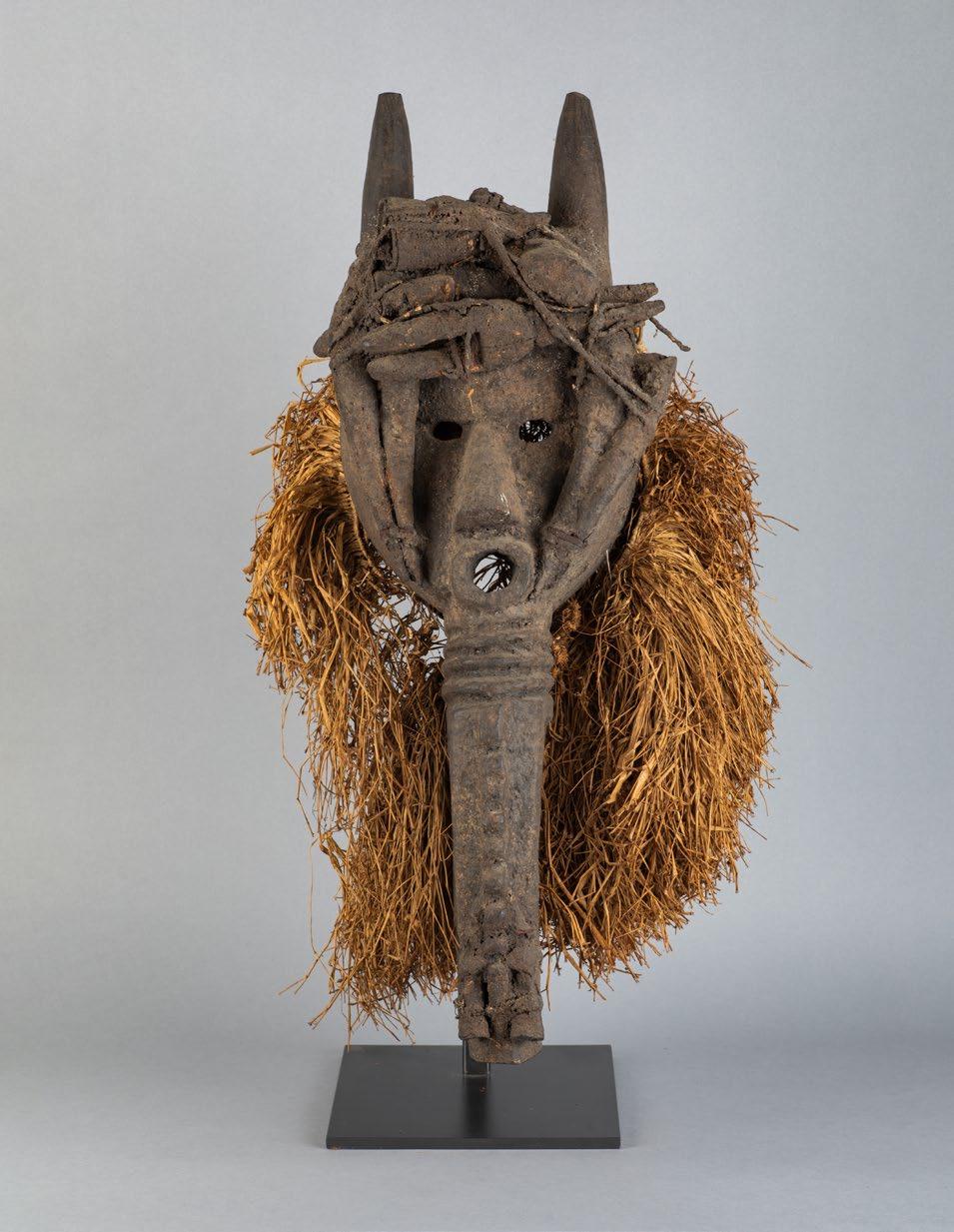
Mask
Maou
Touba region, Ivory Coast
Wood, sacrificial patina
height: 80 cm
Provenance:
Former collection of the ambassador of France
Jean lecannellier, Blainville
Price: 8.000 euros
large and fearcy mask representing a monster at the service of a deity creator of the world. This mask is distinguished by the abundance of its magic charge that increases its power.
O BJECT Pr ESE n TE d By:
laurent dodier
M.: + 33 6 08 22 68 15
E.: laurentdodier@wanadoo.fr
w. : www.laurentdodier.com
v ETTE d By:

l
Zoomorphic headdress Egbukele
ljo / ljaw
nigeria
Wood, pigments and fiber
90 cm
Provenance:
Private collection, France
Tom Slater Gallery, USa
Price on request
O BJECT Pr ESE n TE d By:
Mark Eglinton
M.: +1 646-675-7150
E.: markeglinton@icloud.com
IG: @markeglintontribalart
v ETTE d By:

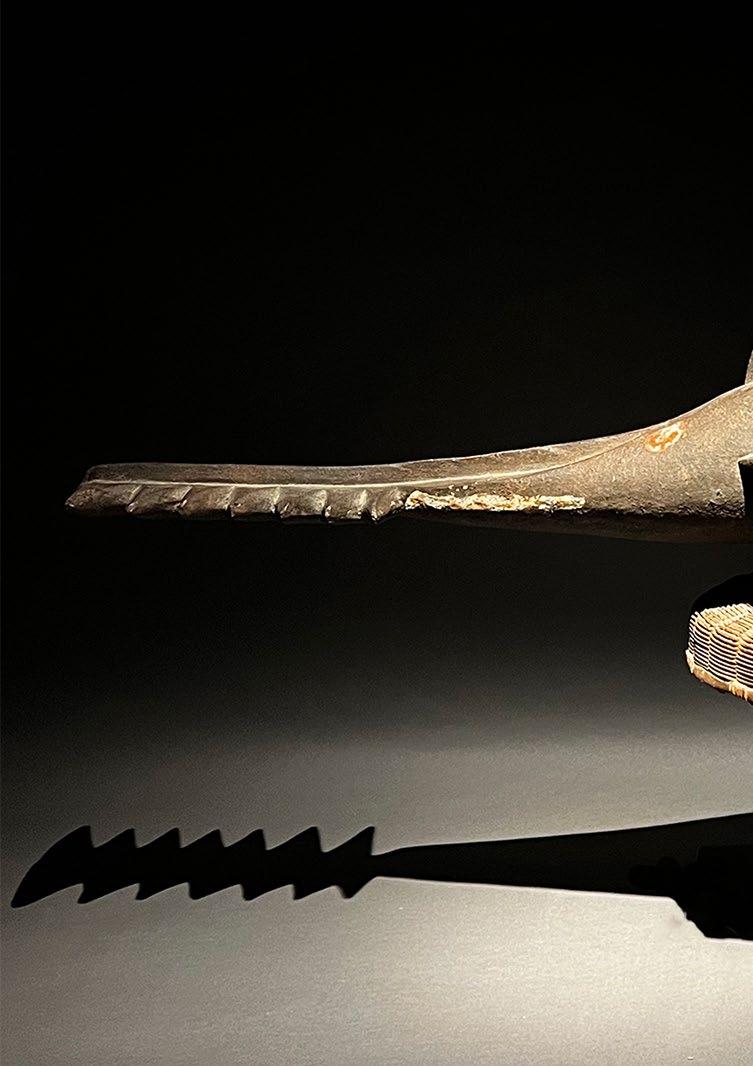


Spain
Early 19th century length: 92,5 cm, the case 94 cm
Provenance:
Formerly in the collection of a Spanish member of the royal house of Savoy Price on request
a walking cane formed from the long tail of a Giant atlantic Eagle ray (Myliobatis aquila), mounted in a silver-gilt handle with coat of arms and ferrule, in original fitted red leather case.
O BJECT Pr ESE n TE d By: rasti Fine art ltd.
M.:+852 2415 1888
E.: gallery@rastifineart.com W: www.rastifineart.com
v ETTE d By:
Miniature mask
Maou Ivory coast
Wood height: 28,5 cm
Price: 2.400 euros
O BJECT Pr ESE n TE d By:
renaud vanuxem
M.: +33 6 07 11 50 60
E.: rvanuxem@yahoo.fr
W. : www.renaudvanuxem.com
v ETTE d By:



TO rq UE
Torque newari
k athmandu valley, nepal
17th century
Gilt copper
22 cm (l) x 19 cm (w) x 3,81 cm(d)
Price on request
O BJECT Pr ESE n TE d By:
Joe loux
T.: +1 505 695 6626
E.: joe@joeloux.com
W. : www.joeloux.com
The mythical newari creature chhepu is the central motif on this ritual ornament. Two traditional necklaces are represented above the chhepu.
v ETTE d By:



Oillamp or candle holder with elephant on pedestal India
19th century Brass
19 cm x 12 cm
Provenance: Private collection Belgium, Mr.P.P Price on request
O BJECT Pr ESE n TE d By:
Farah Massart
M.:+32 495 289 100
E.: art@famarte.be
W: www.famarte.com
v ETTE d By:

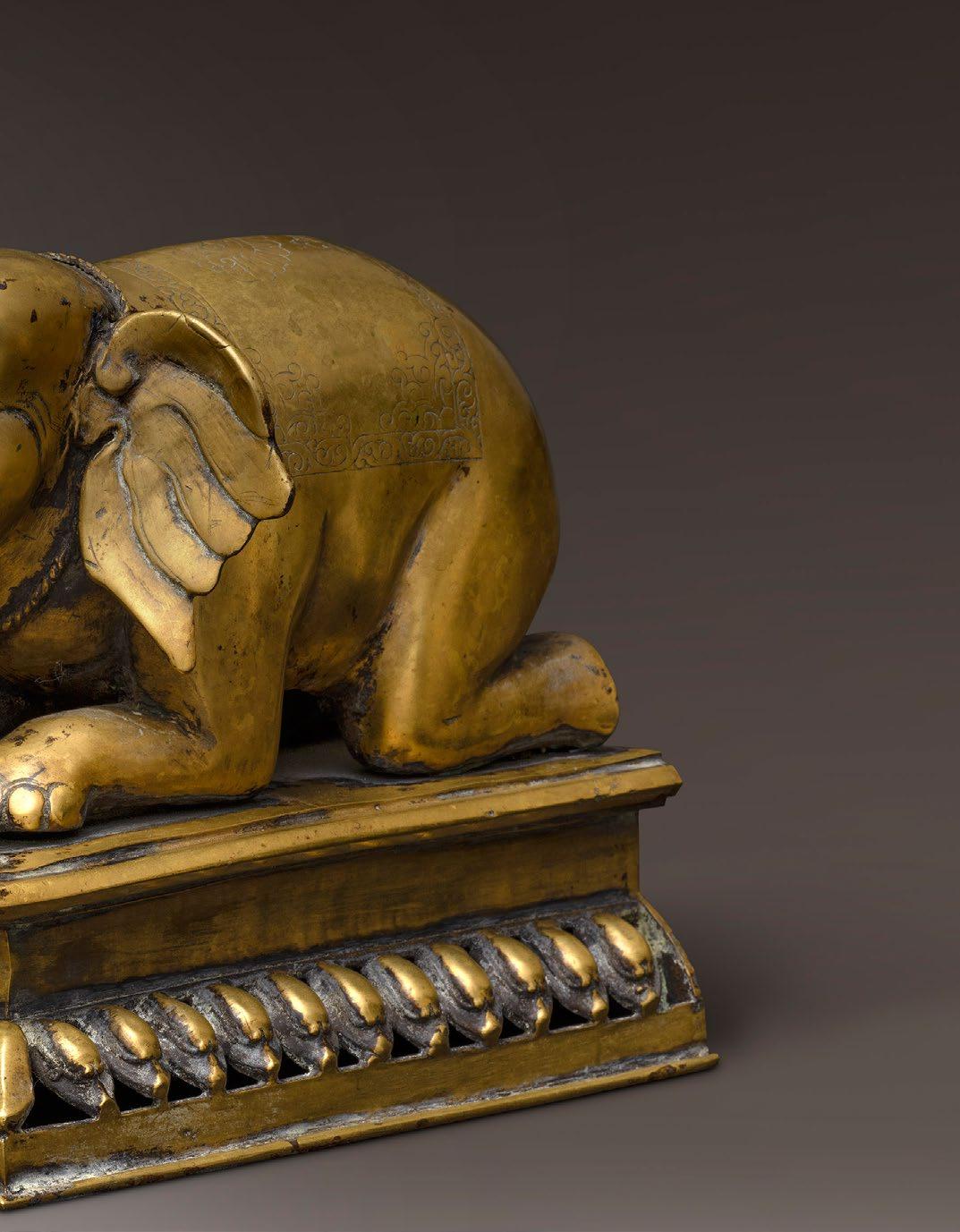
Cups
yunnan, China
End of the 19th century
Eagle claws, lacquered wood
height: 18 cm
Provenance:
Private collection, France
Special price: 1.900 euros
These rare ritual cups whose foot consists of eagle claws - totemic animal of the yi - were manipulated by the shaman.
They were notably exhibited during ceremonies marking military alliances.
O BJECT Pr ESE n TE d By:
Olivier larroque
T.: +33 (0)6 80 08 00 93
E.: o.larroque1@gmail.com
W.: www.olivierlarroque.com
v ETTE d By:


Shamanic amulet / ornament depicting a whale
Thule Culture (ancient Eskimo)
alaska
Prior to the 18th century
Carved walrus tooth length: 3 cm
Provenance:
Jean-Baptiste Bacquart collection, london / Paris
Schmidt collection, london
Special price: 1.300 euros
according to Fitzhugh & k aplan (Inua: Spirit World of the Bering Sea Eskimo, 1982 : 156), these shamanic figurines were carved for several purposes: to stand in for people absent from the village during festivals, to avert infertility, or else to focus the attention of animal inua (spirit) during the doll Festival, which was held to bless hunting and fishing expeditions in the coming year.
Other ethnographic parallels recorded in the early 20th century demonstrate that figurines could be used as personal assistants and “spiritual helpers” to capture prey or as “guardians”to safeguard humankind from those physical and spiritual dangers encountered in the landscape.
O BJECT Pr ESE n TE d By:
Julien Flak
M.: +33 6 84 52 81 36
E.: contact@galerieflak.com
W. : www.galerieflak.com
v ETTE d By:
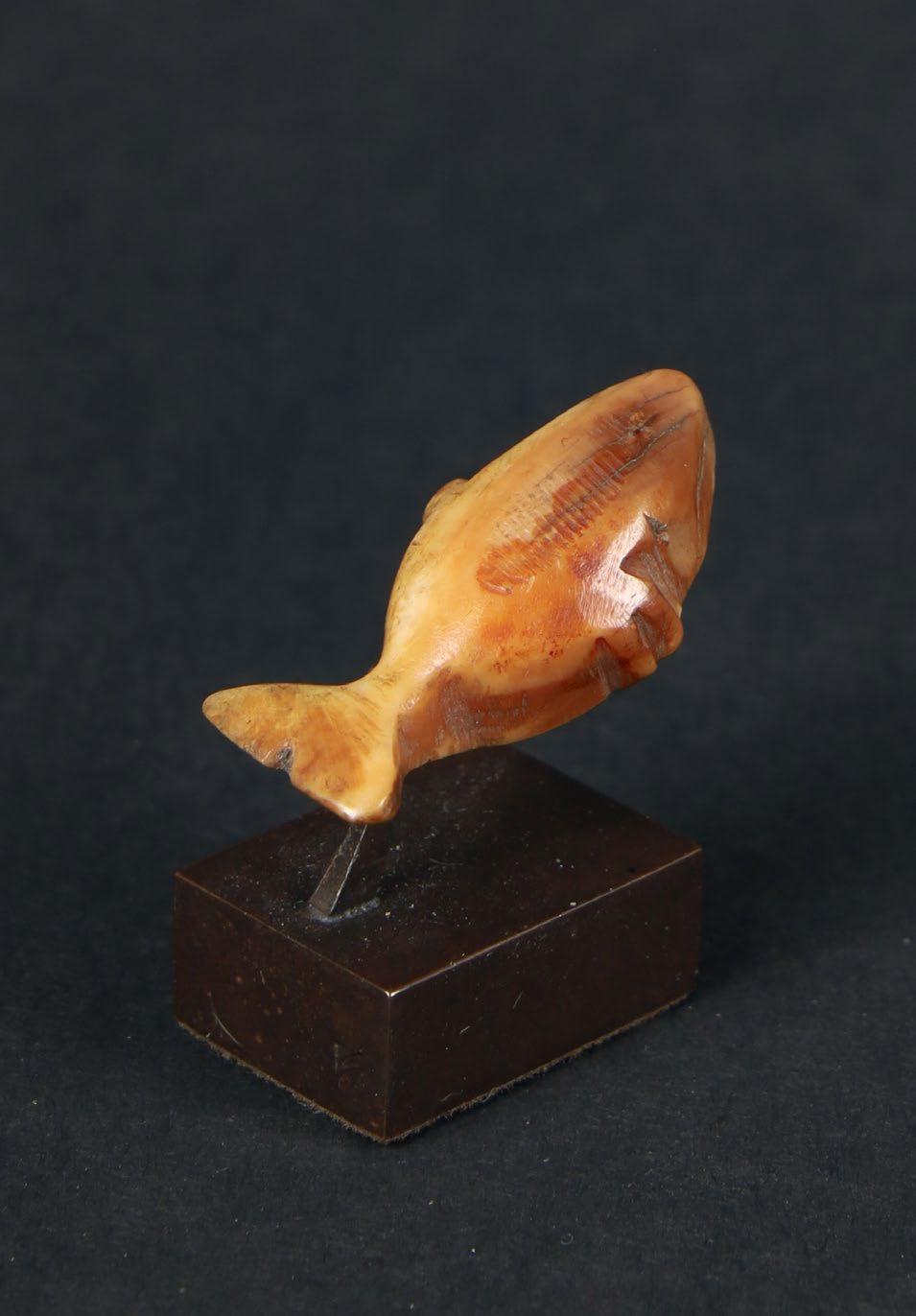


China late Ming dynasty
Jade
5” (12.7 cm) high X 4 ½” (11.5 cm) wide X 6” (15.25 cm) length
Provenance: a Private Collection, Texas Price on request
an archaistic nephrite incense burner, fang ding, of rectangular form with lug handles, standing on four legs carved with lion mask corners, of pale celadon tone, carved in relief with rows of protruding bosses divided by narrow, notched vertical flanges, beneath a border of auspicious characters carved under the lip, together with a carved hongmu stand.
Fang ding, or food containers, produced in bronze during the Shang or early Western Zhou dynasties were one of the most prized of ritual vessels. The presumption for this is that they are found in more opulent tombs along with other ritual bronze vessels such as ding, gu and jue. Often vessels of this type are excavated in pairs suggesting that they were used this way. It was during the Ming dynasty that jade examples began to appear and by the qing dynasty it is clear that they were used decoratively rather than as a ritual vessel.
O BJECT Pr ESE n TE d By:
Clare Chu asian art llC
M:+ 1.310.980.4084
E: clarechuasianart@gmail.com
v ETTE d By:


Wolf head bag handle OBS or Ipiutak ?
northern alaska 200 to 600 ad
Mineralized walrus tusk length: 20,3 cm
Provenance:
Private collection
Price on request
O BJECT Pr ESE n TE d By:
anthony JP Meyer
M.: + 33 (0) 6 80 10 80 22
E.: ajpmeyer@gmail.com
W.: www.meyeroceanic.art
a very rare complex bag handle carved in the form of a "wolf" head spitting out two long rays or a forked tongue with two duck heads carved in relief on the upper register.
Complex designs are carved into the concave side that are a mixture of OBS and Ipiutak motifs.
The wolf head is certainly carved in the Ipiutak style.
v ETTE d By:



China yuan/Ming dynasty
Jade length: 4 ¾” (12 cm)
Provenance:
Mary Morrison, vancouver, Canada
Price on request
O BJECT Pr ESE n TE d By:
Clare Chu asian art llC
M:+ 1.310.980.4084
E: clarechuasianart@gmail.com
v ETTE d By:
a nephrite ‘pebble’ scroll weight, of pale-green tones with a russet skin, carved in the form of a bird of prey, its head with bulging eyes and a hooked beak, turned to one side and almost tucked under one wing, its talons curled beneath its body.

Sri lanka - Ceylon 18th - 19th century
Carved wood with polychrome painted decoration
height: 67 Width: 23 depth: 8,5 cm
Price: 2.500 euros
Yalis are hybrid beasts with parts of birds and lions. They are considered to be mighty guardians or protectors. They are occasionally depicted confronting elephants, in which case they often have one in their maw. The latter feature relates yalis to the kirtimukha, a swallowing fierce monster often found as architectural adornment on temples.
Some depictions of yalis are very ancient, but they are mostly found in South Indian art and architecture from the vijayanagar period onwards.
In monumental interpretations, they are often to be found as wooden architectural elements, for instance in: Jaffer, a. (2002) Luxury Goods from India, london: v&a Publications, p. 67.
O BJECT Pr ESE n TE d By:
alexis renard
T.: + 33 1 44 07 33 02
E.: alexis@alexisrenard.com
W: www.alexisrenard.com
v ETTE d By: